Mark Sisson's Blog, page 28
March 31, 2022
Success Story Update: Six Million Steps Later
Hello, readers! Scott sent in his first success story five years ago. A lot has happened since then, so he’s back with an incredible update. Join me in congratulating Scott and wishing him well!
Now I have a request for you: I consider it a true privilege to publish these real life stories, and I need YOURS to keep this feature going. If you would like to share it with me and the Mark’s Daily Apple community please contact me here. Your journey can inspire others to take those first steps!
 Five years ago, I wrote a success story about living the primal lifestyle to improve my health. After going Primal, I discovered I had advanced stage-four cancer. When I wrote the story, my cancer was in remission, and I had no evidence of disease. But cancer is a sneaky foe, and it didn’t give up as easily as I had hoped.
Five years ago, I wrote a success story about living the primal lifestyle to improve my health. After going Primal, I discovered I had advanced stage-four cancer. When I wrote the story, my cancer was in remission, and I had no evidence of disease. But cancer is a sneaky foe, and it didn’t give up as easily as I had hoped.
Cancer reoccurred in my liver two more times, and it spread to my adrenal glands, more lymph nodes, and my lungs. My original prognosis was that I had about a 7% chance of surviving for five years. Every time my disease spread it lowered my odds of survival. However, that didn’t stop me from living, and I continued to adhere to the primal lifestyle.
While battling cancer my exercise and activity level declined until it was nearly non-existent. Even after losing more than 100 pounds I was still unable to put on my own socks and shoes because I still needed a complete hip replacement. I lacked any flexibility in my hips, and my pain level was through the roof.
Eventually, the time between cancer outbreaks extended and I was able to get hip surgery. It’s difficult to explain the joy of pain-free movement after a decade of suffering. I started walking.
At first, I couldn’t complete a half-mile circuit. A decade of muscle atrophy and surgeries had taken its toll on my core and legs. But my primal diet provided me with energy and the desire to go further. And I got stronger.
In 2019, I committed to a dying friend to complete the Camino de Santiago in Spain in his honor. If you are unfamiliar with the Camino, it’s a pilgrimage across Spain. My route was to be 566 miles. I knew to expect troubles, but I had no idea what I was in store for.
First, my bone density had suffered during my time of inactivity. As I attempted to increase my training, I suffered a couple of stress fractures in my foot. Each occurrence interrupted training for six weeks. I injured myself while training for uphill terrain and got a severe case of plantar fasciitis. That took another 8 weeks off of my training schedule.
 I trained the entire time while taking chemotherapy and receiving radiation treatments. But the Primal lifestyle made it possible to show steady improvement. I switched between primal and keto diets without too many cheat days. I also waited to eat until 4:30 in the afternoon and closed my eating window at 6:30 pm.
I trained the entire time while taking chemotherapy and receiving radiation treatments. But the Primal lifestyle made it possible to show steady improvement. I switched between primal and keto diets without too many cheat days. I also waited to eat until 4:30 in the afternoon and closed my eating window at 6:30 pm.
I still needed to lose a significant amount of weight, and on a long hike, ounces are like pounds. I walked long distances in a fasted state every day. I added to my intermittent fasting by adopting a “no eat Thursday.” I wanted to test my limits for metabolic flexibility and give my autophagy a larger window in which to work. While I don’t suggest my plan as an ideal, it worked extremely well for me.
I would stop eating at 6:30 Wednesday evening and not intake any calories until Friday at 4:30. Except for a little trouble sleeping Thursday night, I suffered no ill effects. I never was tired or weak, and I didn’t reduce my hiking schedule. In fact, I set a goal of 13.1 miles for Thursday and Friday. That way, I would complete an entire 26.2-mile marathon in a fasted state.
In fifteen months, I logged nearly 2200 miles. Excited and nervous, in March 2021 I planned to make travel reservations for my trip to Spain. Oh wait, did I mention the worldwide pandemic? Covid hit the globe, and while on chemo, I was a very high risk. Despite taking precautions, I caught the disease. I had long-haul covid and was very sick for three terrifying weeks. I got a severe case of pneumonia. And though I have no evidence to support this, I believe that my training and diet saved my life.
Despite the setbacks, I never gave in. I had more energy and was more active than I had been since high school. I told my friends that I felt like I was a kid again. The primal lifestyle changed my body, but it also changed my mind. I felt empowered, and my miles were increasing. I knew I wanted to average a daunting 16 miles a day for 35 consecutive days on the Camino.
I eventually managed a 17-mile test hike with a fully loaded, 20 lb. backpack, and I knew I was ready. Unfortunately, Spain would not cooperate. After all my efforts and overcoming many obstacles, most provinces in Spain were still closed to nonessential travel. I cancelled my June 2021 travel plans. My Camino was finished before it began.
But just like the promise I made to myself years ago when I started my primal journey, I was determined to keep this one, at least in spirit. I found a website that offered tracking and other services for completing a virtual Camino. I signed up, loaded up my backpack, and started hiking. I walked around my hometown and on local hiking trails and parks.
I carried everything exactly as if I was in Spain and on my own. I got more than a few strange looks, but people I met were wildly supportive. After a year of lockdown, it was wonderful to reconnect with strangers again.
I’m happy to share that after 38 days I completed my virtual Camino journey on July 4, 2021. Not only have I kept a promise to a dear friend, but I also accomplished something I would consider completely impossible a decade before.

I now weigh less than when I got married thirty-seven years ago. I’m down 175 lbs. since I began the primal lifestyle. I just completed hiking 566 miles, carrying a 20 lb. pack, at 61 years old with stage-4 cancer and two artificial hips. Including training, I’ve logged more than six million steps. Anyone wanting to know what the Primal lifestyle will do for you needs to look no further than at me. This works for anyone at any age.
On a personal note, I’d like to thank Mark Sisson for his incredible contribution. Instead of achieving a major life goal like completing the Camino, I would likely be dead had I not discovered Mark’s Daily Apple. And that’s not hyperbole or exaggeration. I started at the bottom of a huge mountain with no hope until Mark came into my life. Today, I once again show no evidence of cancer and I feel great. The Primal lifestyle is now a habit that requires no effort to follow. On behalf of the hundreds of thousands of others you’ve helped, I’d like to say a big thank you!
(function($) { $("#dfvKh8N").load("https://www.marksdailyapple.com/wp-ad..." ); })( jQuery ); 
The post Success Story Update: Six Million Steps Later appeared first on Mark's Daily Apple.


March 30, 2022
How to Make Butter, Yogurt, and Kefir at Home
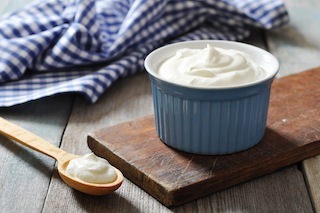 While it’s easy enough to pop down to the grocery store and buy butter, yogurt, or kefir, it can be very rewarding—and easier than you think—to make your own products at home. Making staple dairy foods at home allows you to control what goes into them, control the process, and reconnect to the traditional way of doing things.
While it’s easy enough to pop down to the grocery store and buy butter, yogurt, or kefir, it can be very rewarding—and easier than you think—to make your own products at home. Making staple dairy foods at home allows you to control what goes into them, control the process, and reconnect to the traditional way of doing things.
Yogurt and kefir are also fermented foods that deliver those oh-so-important probiotics to feed the beneficial microbes in your gut. Rather than rely on store-bought products, which often contain sugar and other additives you wish to avoid, why not make your own at home? Being able to make your own butter, yogurt, and kefir gives you flexibility. It gives you power. Most importantly, it gives you agency: the ability to control what you feed yourself or your family.
How to Make ButterThere are some great butters widely available in grocery stores, but sometimes you just want to make something at home. Sometimes you want truly fresh butter.
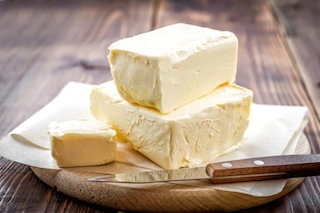
There are a few ways to make butter at home. First, there’s food processor butter. You’ll need:
2 cups of room temperature heavy whipping cream free of additives or binders or stabilizers. Ingredients should read “heavy cream” and nothing else.1 cup of ice cold water1 food processorThe process:
Fill food processor about ½ full with cream and blend at medium speed. As you blend, you will notice that the cream transitions from sloshy to frothy to whipped cream to a very stiff whipped cream.Keep blending until the mixture “seizes” and the whirring you previously enjoyed will now go back to sloshing. This is the butter separating from the buttermilk.Drain the buttermilk (save it for later), then add some of the ice cold water, blend further, and discard the water when it separates.Repeat until the water comes away clear (a process known as washing the butter). Place butter in a large jar and shake to remove any excess water.Store in ramekin, butter dish or in rolls of wax paper. Add salt if you like. Should yield approximately one cup of butter.Next, there’s jar butter. You’ll need:
Room temperature heavy creamA quart jar with a lidThe process:
Fill the jar about halfway.Cover it and shake until the fat clumps together and forms a ball, and the buttermilk separates. This could take about ten minutes.Pour out the buttermilk into a separate container, reserve the clumped fat (butter), and let any excess liquid drain off.To get all the excess buttermilk out for long term storage, knead the butter under running cold water.Salt if you like and store.And finally, there’s this nifty little jar churner. I’ve heard good things from several people.
To spice things up, add a few tablespoons of yogurt to raw cream and let it sit out for a day or two. Once it tastes a little cultured or tangy, use it to make butter.
How to Make YogurtYogurt is one of the oldest ways to consume milk, and of the most nutritious. Good yogurt has little to no lactose (the bacteria digest it), so even the lactose intolerant can usually enjoy it. If you can tolerate dairy, I’d recommend making and eating your own yogurt.
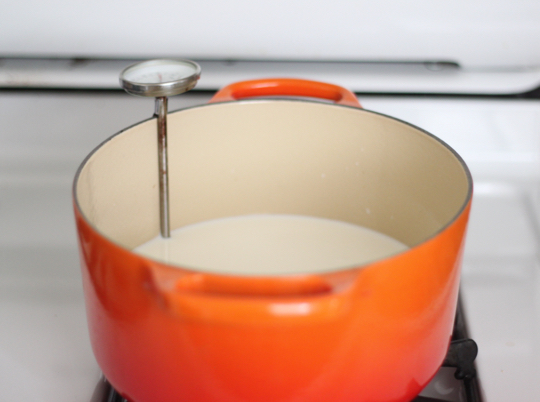
What you’ll need:
A quart of high-quality milk. Raw isn’t necessary because you’ll be heating it, although using raw milk will usually ensure you’re using a high-quality milk.Starter cultureCooking thermometerA starter culture is basically any compound that already has live active cultures in it. You can purchase dry cultures at your local health store or you can use plain yogurt from a previous batch or purchased at a grocery store. However, when doing this, be sure to select a brand of plain yogurt that clearly indicates on its label that it contains live active cultures or else this will not work. To maintain the culture, store the yogurt in the fridge. It’s best to use a yogurt you already enjoy—chances are, the yogurt you make using it will taste similar.
The process:
Pour the milk into a small sauce pan and over low medium heat, heat the milk until it hits 180 degrees F.Remove from heat and let it cool to 105 degrees F.Stir in the yogurt/starter culture and pour into a glass jar or bowl. Cover it.Allow the yogurt to incubate for at least 6-7 hours at 105-112 degrees F. You can do this by using the “yogurt” setting on an Instant Pot, using a yogurt maker, or placing the fermenting yogurt in a pan of hot water whose temperature you monitor and maintain in the 105-112 range.Once the yogurt is thick enough that you can press a spoon into it and see the impression retained, it’s probably ready. Taste it and if you’re happy, store in the fridge. If you want it sourer (indicating more lactose digestion), keep it fermenting.To make Greek-style yogurt, let your finished yogurt drain in a colander lined with cheesecloth. After all the whey has drained out into a bowl, you’re left with the yogurt solids: thick, creamy, and casein-y. Reserve the whey to start new yogurt batches or to just drink straight.
Experiment with different yogurt starter cultures. You can even make yogurt using specific probiotic strains, like Dr. Davis’ L. reuteri yogurt.
Bonus: Turn your homemade yogurt into delicious, herby labneh!
How to Make KefirKefir is “super yogurt”—milk cultured with over a dozen bacterial strains and yeasts. Research shows that kefir is full of unique peptides with beneficial physiological and metabolic effects, most of which have yet to be classified but can assuredly be assumed to be “good for you.” You can find kefir in most grocery stores these days, but the best stuff is made at home using live kefir grains.

You’ll need:
1 tbsp kefir grains1 quart whole milk, ideally raw and organic but if not, high quality un-homogenized milk will workGlass jarYou can order kefir grains online. You can also use Craigslist to try finding someone local with kefir grains to sell (or gift).
The process:
Add your milk to the jar.Add the kefir grains to the jar and cover with a clean cloth with a rubber band.Leave it out on the counter for 1-3 days. The warmer it is, the faster the fermentation occurs.When the contents have thickened and/or separated into whey and solids, it’s ready.Pour the kefir into a plastic colander set over a glass bowl. Some say metal will kill the kefir, although I doubt that, but let’s use plastic just to be safe.Scoop out the grains from the colander and let the liquid fall through into the bowl below, gently pressing the mixture to get everything. The grains will feel solid—they’re unmistakable.Add the grains to another batch of milk to keep the kefir flowing and put the finished kefir into the fridge.You can also add a quarter to a half cup of finished store-bought kefir to a jar of room temperature milk and leave out on the counter. It will ferment, although it won’t be quite the same.
That’s it: a few basic ways to make your own butter, yogurt, and kefir. Have you ever made your own? Do you? Let me know how you do it down below, and thanks for reading!
(function($) { $("#dfgQuJj").load("https://www.marksdailyapple.com/wp-ad..." ); })( jQuery ); 
The post How to Make Butter, Yogurt, and Kefir at Home appeared first on Mark's Daily Apple.


March 29, 2022
How to Read Food Labels
 Grocery shopping can be a tad overwhelming, especially when you’re trying a new way of eating. Primal, paleo, keto, Whole30, vegetarian, vegan—they all have their own set of guidelines about what foods are “allowed” and which you should limit or avoid.
Grocery shopping can be a tad overwhelming, especially when you’re trying a new way of eating. Primal, paleo, keto, Whole30, vegetarian, vegan—they all have their own set of guidelines about what foods are “allowed” and which you should limit or avoid.
Front-of-package food labels allow you to scan the shelves at your supermarket and quickly gather information about products. Depending on which diet or food plan you’re following, you might decide whether or not to grab an item based on:
Food type or ingredients: whether it contains grains, animal products, nightshades, added sugar, etc.Macronutrient profile: low-carb, low-fat, ketoHow ingredients were grown or harvested: organic versus conventional, wild versus farmed, and so onDecoding food labels can be tricky, though. Some claims are subject to strict labeling standards, but others are buzzwords meant to draw your attention and make you think that a product is healthy. “Natural” is a good example of the latter. It sounds like something you’d want, but the term isn’t regulated, so ultimately it doesn’t signify anything specific.
It’s up to you, the consumer, to educate yourself about which labels are meaningful and relevant to you. That way, you can efficiently find products best suited to your needs without being sucked in by meaningless claims and marketing ploys.
How Food Labels Can Help You Shop SmarterFood labels are heuristics—tools for making snappy judgments about which items are up your alley. They can be particularly helpful if you’re following a diet with strict guardrails around what is and is not compliant, such as AIP, or if you have dietary restrictions (you have to avoid gluten or dairy, for example).
However, the icons and claims on the front of the package only tell you so much. They don’t tell you whether a particular product meets your personal standards. I’m pretty sure most Primal folks aren’t going to grab a box of Raisin Bran cereal just because it says “Heart Healthy” on the front and carries the Whole Grain Stamp from the Oldways Whole Grain Council. By the same token, a food could call itself “keto-friendly” and still be made with canola or other oils you typically avoid.
from the Oldways Whole Grain Council. By the same token, a food could call itself “keto-friendly” and still be made with canola or other oils you typically avoid.
Choosy shoppers should start by deciding what qualities are most important to them. Maybe you prioritize organic and non-GMO foods but could care less about keto or vegan certifications. If your doctor told you that you must follow a low-sodium diet, you might want to know how the FDA regulates claims about sodium content,https://www.fda.gov/media/84261/downl... whereas the rest of us probably don’t need to worry about that.
The next step is to learn what different labels actually mean. Who’s in charge of bestowing a given certification or guarantee, and what standards does a product have to meet in order to earn a particular icon? Some food labels and claims are more informative than others.
When shopping, scan the shelves for certification icons and highlighted claims first. Before deciding yes or no, however, flip the product over, read the ingredient list, and check the nutrition facts to confirm they work for you. Here are some labels and icons that Primal consumers may find useful.
Food Labels for Primal, Paleo, and Keto ShoppersNote: These are some of the common food labels you might want to look for, but bear in mind that it’s not a complete list. If you live outside the U.S., your products may carry different labels.
Paleo Certified Paleo
Certified Paleo : Issued by the Paleo Foundation. Certifies that a product contains no grains, legumes, dairy, artificial coloring, preservatives, artificial sweeteners, or artificial flavors. They also have rules governing allowed ingredients, including approved types of fats and oils, sweeteners, and meat and seafood.https://paleofoundation.com/wp-conten...
: Issued by the Paleo Foundation. Certifies that a product contains no grains, legumes, dairy, artificial coloring, preservatives, artificial sweeteners, or artificial flavors. They also have rules governing allowed ingredients, including approved types of fats and oils, sweeteners, and meat and seafood.https://paleofoundation.com/wp-conten...
 Keto Certified
Keto Certified : Issued by the Paleo Foundation. Products may not contain partially-hydrogenated oils or trans fats, artificial sweeteners (saccharin, cyclamate, acesulfame, aspartame, sucralose), or artificial flavors. Approved ingredients include everything you’d find in the Primal Food Pyramid, including dairy. In this case, grains and legumes are allowed as long as the product does not exceed carbohydrate limits: Meals and meal replacements may not contain more than 10 grams of net carbs per serving; snacks no more than 6 grams of net carbs per serving; and condiments no more than 2 grams of net carbs per 0.5 ounce serving. https://paleofoundation.com/wp-conten...
: Issued by the Paleo Foundation. Products may not contain partially-hydrogenated oils or trans fats, artificial sweeteners (saccharin, cyclamate, acesulfame, aspartame, sucralose), or artificial flavors. Approved ingredients include everything you’d find in the Primal Food Pyramid, including dairy. In this case, grains and legumes are allowed as long as the product does not exceed carbohydrate limits: Meals and meal replacements may not contain more than 10 grams of net carbs per serving; snacks no more than 6 grams of net carbs per serving; and condiments no more than 2 grams of net carbs per 0.5 ounce serving. https://paleofoundation.com/wp-conten...
In the U.S., the word “keto” can’t appear on meat, poultry, or egg products inspected by the USDA. The FDA considers keto a “medical diet,” and the USDA, which is responsible for meat, poultry, and egg labeling, does not allow for health claims. It’s a good reminder that food labels can certainly be helpful, but you shouldn’t rely on them entirely to make your shopping decisions. Meat, poultry, and eggs are staples of most keto diets, no matter what the package does (or, in this case, doesn’t) say.
Whole30 Whole30 Approved®: Consistent with the rules of the Whole30® program, meaning no added sugar or sweeteners, grains, legumes, dairy, carrageenan, or sulfites. Must also meet Whole30’s Animal Welfare Policy.https://whole30.com/whole30-approved/...
Whole30 Approved®: Consistent with the rules of the Whole30® program, meaning no added sugar or sweeteners, grains, legumes, dairy, carrageenan, or sulfites. Must also meet Whole30’s Animal Welfare Policy.https://whole30.com/whole30-approved/...
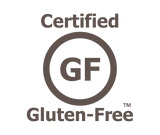 Certified Gluten-Free
Certified Gluten-Free : Product has been independently verified to be gluten-free by the Gluten-Free Certification Organization. In order to earn the certification, a product and its ingredients cannot exceed the gluten threshold of 10 ppm (parts per million).https://gfco.org/">5
: Product has been independently verified to be gluten-free by the Gluten-Free Certification Organization. In order to earn the certification, a product and its ingredients cannot exceed the gluten threshold of 10 ppm (parts per million).https://gfco.org/">5
In the U.S., a food manufacturer can also label a product as gluten-free according to the FDA if it contains less than 20 ppm of gluten and does not utilize gluten-containing grains (wheat, rye, barley) or ingredients derived from those grains unless they have been processed to remove gluten.https://www.fda.gov/food/nutrition-ed...
Vegan Certified Vegan
Certified Vegan : Administered by the Vegan Awareness Foundation. Products can’t contain an animal-based ingredients, ingredients may not be processed with any animal byproducts, and must not contain any animal-derived GMOs. Ingredients and finished products may not be tested on animals. Companies certify that manufacturing facilities take steps to avoid cross-contamination with non-vegan products.https://vegan.org/certification/"...
: Administered by the Vegan Awareness Foundation. Products can’t contain an animal-based ingredients, ingredients may not be processed with any animal byproducts, and must not contain any animal-derived GMOs. Ingredients and finished products may not be tested on animals. Companies certify that manufacturing facilities take steps to avoid cross-contamination with non-vegan products.https://vegan.org/certification/"...
 Non-GMO Project Verified
Non-GMO Project Verified : Seal of approval given by The Non-GMO Project affirming that a product was manufactured without genetically modified organisms.https://www.nongmoproject.org/product...
: Seal of approval given by The Non-GMO Project affirming that a product was manufactured without genetically modified organisms.https://www.nongmoproject.org/product...
Just Eat Meat and Vegetables?
I’m sure some of you are thinking, “Just eat meat and vegetables, then you won’t have to worry about food labels.” That may be okay for some people, but many foods that come with a label are totally Primal-friendly. Think sauces and condiments, nut butters, snack foods made with grain-free flours.
And don’t forget, meat, eggs, and prepared or frozen fruit and vegetables all carry package claims. These, too, vary in terms of how informative they actually are. Appealing terms like “sustainably farmed” or “humanely raised” aren’t regulated in the U.S. “Cage-free” eggs come from chickens that weren’t confined to cages, but that designation tells you next to nothing about the animals’ diet or living conditions.
Even the “just eat meat and vegetables” crowd will benefit from understanding food labels, assuming they want to prioritize farming, fishing, and animal rearing practices that are better for humans and the environment. Here are some Mark’s Daily Apple Posts that can help get you started:
How to Buy (and Appreciate) EggsChoosing Chicken: A Primal Purchasing GuideDear Mark: Cheap Meat?The Differences Between Grass-Fed Beef and Grain-Fed BeefWhat about you? What are your priorities while wandering the supermarket?
References https://www.fda.gov/media/84261/downloadhttps://paleofoundation.com/wp-content/uploads/2020/04/Certified-Paleo-Standards-2020.pdfhttps://paleofoundation.com/wp-content/uploads/2021/02/KETO-Certified-2021-pdf.pdfhttps://whole30.com/whole30-approved/https://gfco.org/https://www.fda.gov/food/nutrition-education-resources-materials/gluten-and-food-labelinghttps://vegan.org/certification/https://www.nongmoproject.org/product-verification/ (function($) { $("#dfE4T3I").load("https://www.marksdailyapple.com/wp-ad..." ); })( jQuery );
The post How to Read Food Labels appeared first on Mark's Daily Apple.


March 26, 2022
Warm Spinach Salad Recipe
 “Warm” and “salad” might not be two words you’d normally associate, but we promise you that this warm spinach salad recipe has the goods!
“Warm” and “salad” might not be two words you’d normally associate, but we promise you that this warm spinach salad recipe has the goods!
This high-protein salad boasts colorful, nutrient-dense veggies and healthy fats. Roughly chopping the greens ensures that you get bite-sized greens in every delicious bite, and the crispy bacon, crunchy apples, and perfectly roasted butternut squash are downright delightful together.
It’s is also very versatile and customizable. Spinach salad is a classic, but any greens—baby kale, Swiss chard, beet greens, or a combination—will work here. Instead of butternut squash, substitute delicata squash or kabocha. Swap out the walnuts for pecans or pine nuts and the goat cheese for feta. Try it with ranch dressing instead of honey mustard. You can’t go wrong. Once you get the warm spinach salad experience, you’ll want to try loads of different variations.
Warm Spinach SaladServes: 4
Time in the kitchen: 50 minutes
Ingredients5 oz. baby spinach5 oz. baby arugula8 slices (about 6 oz) bacon3 cups cubed butternut squash1 red onion, thinly sliced1/3 cup roughly chopped walnuts1 lb. shredded or chopped cooked chicken4 hard-boiled eggs, peeled and sliced or quartered (see hard-boiling instructions below)1/4-1/3 cup Primal Kitchen Honey Mustard DressingOptional: 1 apple, cubedOptional: 4 oz. goat cheese, crumbled
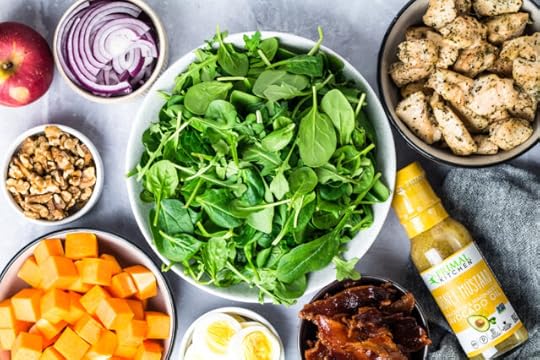
Preheat your oven to 375 degrees Fahrenheit (190 degrees Celsius).
Lay your bacon out on a rimmed sheet pan and bake it in the oven until it reaches your desired crispiness. This will probably take about 20 minutes, but start checking after 15. Use tongs to remove the bacon to a towel-lined plate. When it is cool enough to handle, roughly chop the bacon and set it aside.
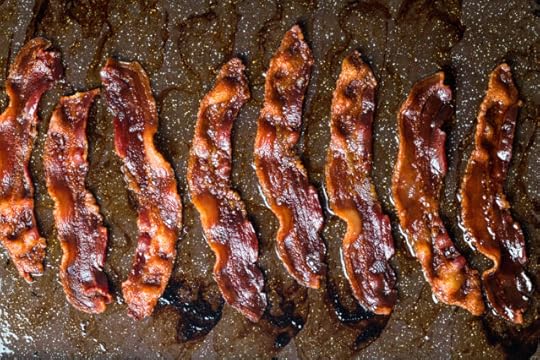
Meanwhile, carefully toss the cubed butternut squash in the bacon fat in the baking sheet. Arrange the butternut squash in a single layer, then place the pan back in the oven and roast for 20 minutes. Flip the squash over and bake for an additional 5 to 10 minutes, or until the squash is golden. Place the squash in a bowl large enough to toss all the salad ingredients.
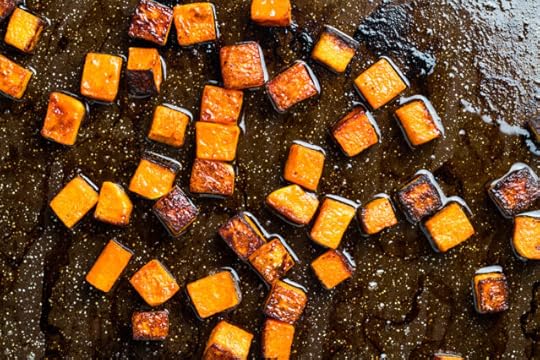
Add the chopped bacon back to the pan and place the pan back in the oven for a few minutes to get the bacon warm again. While the bacon is warming, roughly chop the baby spinach and arugula leaves in batches so they’re in bite-sized pieces.
Add the warm bacon, sliced onion, walnuts, chicken, and apple and/or cheese if you’re adding them to the bowl with the squash. Gently toss the ingredients with the Primal Kitchen Honey Mustard dressing.
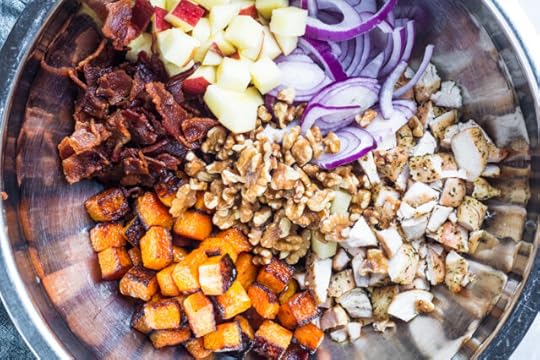
Add the chopped greens and egg and gently toss so everything is combined. As you toss the salad together, the arugula and spinach will wilt slightly. Enjoy right away or save leftovers for the next day.

I have a whole post on How to Cook Eggs Perfectly, Every Time. Here are the highlights:
Fill a pot of water about half full with water and a pinch of salt. Bring it to a boil.Carefully add your eggs to the hot water.For fully cooked yolks, cook the eggs for 10 minutes.Transfer the eggs to a bowl of ice water. Peel when they are cool enough to handle.Check out the other post for more detailed instructions. For this warm spinach salad, you can also omit the hard-boiled eggs and top the tossed salad with poached eggs. Instructions for poaching eggs are in that same post. Enjoy!
Nutrition Facts (¼ of recipe):Calories: 446Fat: 25 gramsTotal Carbs: 22 gramsNet Carbs: 17 gramsProtein: 35 gramsPrint.tasty-recipes-print-button{background-color:#667;border:none;display:inline-block;padding:.5em 1em;text-decoration:none}body:not(.tasty-recipes-print-view) .tasty-recipes-print-button.tasty-recipes-print-above-card{color:#fff;display:none}body:not(.tasty-recipes-print-view) .tasty-recipes-print-button.tasty-recipes-print-above-card:hover{background-color:#b2b2bb;color:#fff;display:inline-block;padding:.5em 1em;text-decoration:none}.tasty-recipes-image-button-container{display:flex;flex-direction:column;flex-wrap:wrap;float:right;margin-left:10px}body.tasty-recipes-print-view .tasty-recipes-buttons{display:none}.tasty-recipes-image-button-container .tasty-recipes-buttons{margin-bottom:10px;margin-top:10px}.tasty-recipes-image-button-container .tasty-recipes-button-wrap{box-sizing:border-box;margin-bottom:10px}.tasty-recipes-image-button-container .tasty-recipes-buttons a{background-color:#f9f9f9;border:1px solid #aaa;border-radius:0;color:#aaa;display:block;font-size:16px;font-weight:700;line-height:16px;margin-top:0;padding:8px;text-align:center;text-decoration:none;text-transform:uppercase}.tasty-recipes-image-button-container .tasty-recipes-buttons .button:hover{background-color:#aaa;border:1px solid #aaa;color:#fff;opacity:1}.tasty-recipes-image-button-container .tasty-recipes-buttons a:hover{background-color:#979599;text-decoration:none}.tasty-recipes-image-button-container .tasty-recipes-buttons svg{display:none}.tasty-recipes-yield-scale{border:1px solid #979599;border-radius:2px;color:#979599;font-size:.7rem;margin-left:3px;padding:0 4px}.tasty-recipes-units-scale-container{display:flex;flex-wrap:wrap}.tasty-recipes-convert-container{padding:0 1em 1em 0}.tasty-recipes-convert-container .tasty-recipes-convert-label{align-self:center;color:#979599;font-size:.6rem;text-transform:uppercase}.tasty-recipes-convert-container button{background:transparent;border:1px solid #979599;border-radius:2px;color:#979599;letter-spacing:0;margin-left:5px;min-width:34px;padding:2px 4px;text-align:center}.tasty-recipes-convert-container button.tasty-recipes-convert-button-active{border-color:#353547;color:#353547}.tasty-recipes-convert-container button:focus{outline:none}.tasty-recipes-scale-container{display:flex;padding:0 0 1em}.tasty-recipes-scale-container .tasty-recipes-scale-label{align-self:center;color:#979599;font-size:.6rem;text-transform:uppercase}.tasty-recipes-scale-container button{background:transparent;border:1px solid #979599;border-radius:2px;color:#979599;letter-spacing:0;margin-left:5px;min-width:34px;padding:2px 4px}.tasty-recipes-scale-container button.tasty-recipes-scale-button-active{border-color:#353547;color:#353547}.tasty-recipes-scale-container button:focus{outline:none}.tasty-recipes-ingredients-header{margin:1em 0}@media only screen and (min-width:520px){.tasty-recipes-ingredients-header{align-items:center;display:flex;flex-wrap:wrap;justify-content:space-between}}.tasty-recipes-ingredients-header .tasty-recipes-ingredients-clipboard-container{align-items:baseline;display:inline-flex}.tasty-recipes-ingredients-header h3{margin:0 10px 10px 0}.tasty-recipes-ingredients-clipboard-container .tasty-recipes-copy-button{background:transparent;border:none;color:#353547;height:24px;padding:0;position:relative;width:24px}.tasty-recipes-ingredients-clipboard-container .tasty-recipes-copy-button:hover{opacity:.5}.tasty-recipes-instructions-header{align-items:baseline;display:flex;flex-wrap:wrap;justify-content:space-between;margin:1em 0}.tasty-recipes-entry-content .tasty-recipes-instructions h3{margin:0 0 1rem}@media only screen and (min-width:520px){.tasty-recipes-entry-content .tasty-recipes-instructions h3{margin:0}}button[name=tasty-recipes-video-toggle]{background:#979599;border:#979599;border-radius:2px;display:inline-block;font-size:14px;height:30px;line-height:20px;margin:0;padding:0;text-align:center;vertical-align:middle;width:86px}button[name=tasty-recipes-video-toggle] span{padding:0 4px;pointer-events:none}button[name=tasty-recipes-video-toggle][aria-checked=false] :last-child,button[name=tasty-recipes-video-toggle][aria-checked=true] :first-child{background:#fff;border-radius:2px;color:#979599;padding:2px 4px}button[name=tasty-recipes-video-toggle][aria-checked=false] :first-child,button[name=tasty-recipes-video-toggle][aria-checked=true] :last-child{color:#fff}label[for=tasty-recipes-video-toggle]{color:#979599;font-size:.6rem;line-height:30px;padding-right:8px;text-transform:uppercase;user-select:none;-moz-user-select:none;-ms-user-select:none;-webkit-user-select:none;-o-user-select:none;vertical-align:middle}.tasty-recipe-responsive-iframe-container{margin:10px 0}.tasty-recipes-equipment{display:flex;flex-wrap:wrap;justify-content:space-evenly}.tasty-recipes-equipment>h3{flex:0 0 100%}.tasty-recipes-equipment .tasty-link-card{flex:0 0 50%;padding:1.5rem 1rem;text-align:center}@media screen and (min-width:500px){.tasty-recipes-equipment .tasty-link-card{flex:0 0 33%}}.tasty-recipes-equipment .tasty-link-card p{font-size:1em;font-weight:700;margin-bottom:0}.tasty-recipes-equipment .tasty-link-card p a{color:initial}.tasty-recipes-equipment .tasty-link-card span{font-size:.9em}.tasty-recipes .tasty-recipes-nutrition ul{list-style-type:none;margin:0;padding:0}.tasty-recipes .tasty-recipes-nutrition ul:after{clear:both;content:" ";display:block}.tasty-recipes .tasty-recipes-nutrition li{float:left;list-style-type:none;margin-bottom:0;margin-left:0;margin-right:16px}.tasty-recipes-plug{align-items:center;display:flex;flex-wrap:wrap;justify-content:center;margin-bottom:1em;text-align:center}.tasty-recipes-plug a{box-shadow:none;text-decoration:none}.tasty-recipes-plug a img{display:inline-block;height:auto;margin:5px 0 0 8px;width:150px}.tasty-recipes-footer-content{padding:1.5em;text-align:center}.tasty-recipes-footer-content .tasty-recipes-footer-copy{margin-left:0}.tasty-recipes-footer-content img,.tasty-recipes-footer-content svg{width:60px}.tasty-recipes-entry-content .tasty-recipes-entry-footer h3{font-size:1.25em;margin:0 0 .25em;padding:0}.tasty-recipes-entry-footer p{font-size:.75em;margin:0}.tasty-recipes-entry-footer p a{border-bottom:none;box-shadow:none;text-decoration:underline}.tasty-recipes-flash-message{background-color:#fff;border-radius:4px;box-shadow:0 .3px .4px 0 rgba(0,0,0,.024),0 .9px 1.5px 0 rgba(0,0,0,.05),0 3.5px 6px 0 rgba(0,0,0,.1);color:#313135;display:inline-block;font-size:13px;letter-spacing:0;line-height:1.2em;margin-left:10px;padding:4px 10px}@media screen and (min-width:500px){.tasty-recipes-flash-message{padding:4px 10px}}.tasty-recipes-flash-message p{margin:0;padding:0;text-transform:none}@media screen and (min-width:500px){.tasty-recipes-footer-content{align-items:center;display:flex;justify-content:center;padding:1.5em 0;text-align:left}.tasty-recipes-footer-content .tasty-recipes-footer-copy{margin-left:.8em}}@media print{.tasty-recipes-no-print,.tasty-recipes-no-print *{display:none!important}}[data-tr-ingredient-checkbox]{cursor:pointer;list-style-position:outside;list-style-type:none!important;margin-left:0!important}[data-tr-ingredient-checkbox] .tr-ingredient-checkbox-container{position:relative}[data-tr-ingredient-checkbox] .tr-ingredient-checkbox-container input[type=checkbox]+label{display:inline-block;position:relative;vertical-align:middle}[data-tr-ingredient-checkbox] .tr-ingredient-checkbox-container input[type=checkbox]{clip:rect(1px 1px 1px 1px);clip:rect(1px,1px,1px,1px);height:1px;overflow:hidden;position:absolute!important;width:1px}[data-tr-ingredient-checkbox] .tr-ingredient-checkbox-container input[type=checkbox]+label:before{border:1px solid;border-radius:2px;content:"";display:inline-block;height:20px;margin-right:10px;position:relative;width:20px}[data-tr-ingredient-checkbox] .tr-ingredient-checkbox-container input[type=checkbox]:checked+label:after{border-bottom:2px solid;border-left:2px solid;content:"";display:inline-block;height:6px;left:4px;position:absolute;top:4px;transform:rotate(-45deg);width:12px}[data-tr-ingredient-checkbox] .tr-ingredient-checkbox-container input[type=checkbox]:focus+label:before{box-shadow:0 0 8px #5e9ed6;outline:1px solid #5d9dd5}[data-tr-ingredient-checkbox=checked]{opacity:.8;text-decoration:line-through}/* Bold recipe card styles. */ .tasty-recipes{border:5px solid #667;margin-top:6em;margin-bottom:4em}.tasty-recipes.tasty-recipes-has-plug{margin-bottom:1em}.tasty-recipes-plug{margin-bottom:4em}.tasty-recipes-print-button{display:none}.tasty-recipes-image-shim{height:69.5px;clear:both}.tasty-recipes-entry-header{background-color:#667;color:#fff;text-align:center;padding-top:35px;padding-bottom:1.5em;padding-left:2.5em;padding-right:2.5em}.tasty-recipes-entry-header.tasty-recipes-has-image{padding-top:0px}.tasty-recipes-entry-header .tasty-recipes-image{float:none;text-align:center;transform:translateY(-115px);margin-bottom:1em;/* Decide if we need this */}.tasty-recipes-entry-header .tasty-recipes-image img{-webkit-border-radius:50%;-moz-border-radius:50%;border-radius:50%;border:5px solid #667;height:150px;width:150px;display:inline-block;object-fit:cover}.tasty-recipes-entry-header h2{font-size:2em;font-weight:400;text-transform:lowercase;margin-bottom:0;text-align:center;color:#fff;margin-top:0;padding-top:0;padding-bottom:0}.tasty-recipes-has-image .tasty-recipes-entry-header h2{margin-top:-115px}.tasty-recipes-entry-header hr{border:1px solid #b7bbc6;background-color:#b7bbc6;margin-bottom:1em;margin-top:1em}.tasty-recipes-entry-header div.tasty-recipes-rating{text-decoration:none;border:none}.tasty-recipes-entry-header .tasty-recipes-rating:hover{text-decoration:none}.tasty-recipes-entry-header div.tasty-recipes-rating{font-size:1.375em;display:block}.tasty-recipes-entry-header .tasty-recipes-rating p{margin-bottom:0}.tasty-recipes-entry-header span.tasty-recipes-rating{margin-left:0.25em;margin-right:0.25em;color:#fff}.tasty-recipes-entry-header .rating-label{font-style:italic;color:#b7bbc6;font-size:0.6875em;display:block}.tasty-recipes-entry-header .tasty-recipes-details{margin-top:1em}.tasty-recipes-entry-header .tasty-recipes-details ul{list-style-type:none;margin:0}.tasty-recipes-entry-header .tasty-recipes-details ul li{display:inline-block;margin-left:0.5em;margin-right:0.5em;font-size:1em;line-height:2.5em;color:#fff}@media only screen and (max-width:520px){.tasty-recipes-entry-header .tasty-recipes-details .detail-icon{height:0.8em;margin-top:0.4em}.tasty-recipes-entry-header .tasty-recipes-details ul li{font-size:0.875em;line-height:1.75em}}@media only screen and (min-width:520px){.tasty-recipes-entry-header .tasty-recipes-details .detail-icon{height:1em;margin-top:0.6em}.tasty-recipes-entry-header .tasty-recipes-details ul li{font-size:1em;line-height:2.5em}}.tasty-recipes-entry-header .tasty-recipes-details .tasty-recipes-label{font-style:italic;color:#b7bbc6;margin-right:0.125em}.tasty-recipes-entry-header .tasty-recipes-details .detail-icon{vertical-align:top;margin-right:0.2em;display:inline-block;color:#FFF}.tasty-recipes-entry-header .tasty-recipes-details .author a{color:inherit;text-decoration:underline}.tasty-recipes-entry-content{padding-top:1.25em}.tasty-recipes-entry-content .tasty-recipes-buttons{margin-bottom:1.25em;margin-left:1.25em;margin-right:1.25em}.tasty-recipes-entry-content .tasty-recipes-buttons:after{content:' ';display:block;clear:both}.tasty-recipes-entry-content .tasty-recipes-button-wrap{width:50%;display:inline-block;float:left;box-sizing:border-box}.tasty-recipes-entry-content .tasty-recipes-buttons a{text-transform:uppercase;text-align:center;display:block;color:#fff;background-color:#667;font-size:1em;line-height:1.375em;padding-top:1em;padding-bottom:1em;font-weight:bold;margin-top:0;border:none;border-radius:0;text-decoration:none}.tasty-recipes-entry-content a img{box-shadow:none;-webkit-box-shadow:none}.tasty-recipes-entry-content .tasty-recipes-buttons a:hover{background-color:#979599;text-decoration:none}.tasty-recipes-entry-content .tasty-recipes-buttons img{vertical-align:top}.tasty-recipes-entry-content .tasty-recipes-buttons .svg-print,.tasty-recipes-entry-content .tasty-recipes-buttons .svg-pinterest,.tasty-recipes-entry-content .tasty-recipes-buttons .svg-heart-regular,.tasty-recipes-entry-content .tasty-recipes-buttons .svg-heart-solid{height:1.25em;margin-right:0.375em;margin-bottom:0;background:none;display:inline-block;vertical-align:middle}@media only screen and (min-width:520px){.tasty-recipes-entry-content .tasty-recipes-button-wrap:first-child{padding-right:0.625em}.tasty-recipes-entry-content .tasty-recipes-button-wrap:last-child{padding-left:0.625em}}@media only screen and (max-width:520px){.tasty-recipes-entry-content .tasty-recipes-button-wrap{width:100%}.tasty-recipes-entry-content .tasty-recipes-button-wrap:nth-child(2){padding-top:1em}}.tasty-recipes-entry-content h3{text-transform:uppercase;font-size:0.75em;color:#979599;margin:1.5em 0}.tasty-recipes-ingredients-header,.tasty-recipes-instructions-header{margin:1.5em 0}.tasty-recipes-entry-content h4{font-size:1em;padding-top:0;margin-bottom:1.5em;margin-top:1.5em}.tasty-recipes-entry-content hr{background-color:#eae9eb;border:1px solid #eae9eb;margin-top:1em;margin-bottom:1em}.tasty-recipes-entry-content .tasty-recipes-description,.tasty-recipes-entry-content .tasty-recipes-ingredients,.tasty-recipes-entry-content .tasty-recipes-instructions,.tasty-recipes-entry-content .tasty-recipes-keywords{padding-left:1.25em;padding-right:1.25em}.tasty-recipes-entry-content .tasty-recipes-description h3{display:none}.tasty-recipes-entry-content .tasty-recipes-description p{margin-bottom:1em}.tasty-recipes-entry-content .tasty-recipes-ingredients ul,.tasty-recipes-entry-content .tasty-recipes-instructions ul{list-style-type:none;margin-left:0;margin-bottom:1.5em;padding:0}.tasty-recipes-entry-content .tasty-recipes-ingredients ul li,.tasty-recipes-entry-content .tasty-recipes-instructions ul li{margin-bottom:0.625em;list-style-type:none;position:relative;margin-left:1.5em;line-height:1.46}.tasty-recipes-entry-content .tasty-recipes-ingredients ul li:before,.tasty-recipes-entry-content .tasty-recipes-instructions ul li:before{background-color:#667;-webkit-border-radius:50%;-moz-border-radius:50%;border-radius:50%;height:0.5em;width:0.5em;display:block;content:' ';left:-1.25em;top:0.375em;position:absolute}.tasty-recipes-entry-content .tasty-recipes-ingredients ol,.tasty-recipes-entry-content .tasty-recipes-instructions ol{counter-reset:li;margin-left:0;padding:0}.tasty-recipes-entry-content .tasty-recipes-ingredients ol>li,.tasty-recipes-entry-content .tasty-recipes-instructions ol>li{list-style-type:none;position:relative;margin-bottom:1em;margin-left:1.5em;line-height:1.46}.tasty-recipes-entry-content .tasty-recipes-ingredients ol>li:before,.tasty-recipes-entry-content .tasty-recipes-instructions ol>li:before{content:counter(li);counter-increment:li;position:absolute;background-color:#667;-webkit-border-radius:50%;-moz-border-radius:50%;border-radius:50%;height:1.45em;width:1.45em;color:#fff;left:-1.25em;transform:translateX(-50%);line-height:1.5em;font-size:0.6875em;text-align:center;top:0.1875em}.tasty-recipes-entry-content .tasty-recipes-ingredients li li,.tasty-recipes-entry-content .tasty-recipes-instructions li li{margin-top:0.625em}.tasty-recipes-entry-content .tasty-recipes-ingredients li ul,.tasty-recipes-entry-content .tasty-recipes-ingredients li ol,.tasty-recipes-entry-content .tasty-recipes-instructions li ul,.tasty-recipes-entry-content .tasty-recipes-instructions li ol{margin-bottom:0}.tasty-recipes-entry-content .tasty-recipes-equipment{padding-left:1.25em;padding-right:1.25em}.tasty-recipes-entry-content .tasty-recipe-video-embed~.tasty-recipes-equipment{padding-top:1em}.tasty-recipes-entry-content .tasty-recipes-notes{padding:1.25em;background-color:#edf0f2}.tasty-recipes-entry-content .tasty-recipes-notes ol{counter-reset:li;margin-left:0;padding:0}.tasty-recipes-entry-content .tasty-recipes-notes ul{margin-left:0;padding:0}.tasty-recipes-entry-content .tasty-recipes-notes p,.tasty-recipes-entry-content .tasty-recipes-notes ul,.tasty-recipes-entry-content .tasty-recipes-notes ol{background-color:#fff;padding-left:1.5625em;padding-right:1.5625em;padding-top:1.25em;padding-bottom:1.25em;margin-bottom:1.5em;position:relative;-webkit-clip-path:polygon(20px 0,100% 0,100% 100%,0 100%,0 20px);clip-path:polygon(20px 0,100% 0,100% 100%,0 100%,0 20px)}@media only screen and (min-width:520px){.tasty-recipes-entry-content .tasty-recipes-notes ul,.tasty-recipes-entry-content .tasty-recipes-notes ol{margin-left:2em}.tasty-recipes-entry-content .tasty-recipes-notes p,.tasty-recipes-entry-content .tasty-recipes-notes ul li,.tasty-recipes-entry-content .tasty-recipes-notes ol li{padding-left:2.5em}.tasty-recipes-entry-content .tasty-recipes-notes ul li,.tasty-recipes-entry-content .tasty-recipes-notes ol li{position:relative;list-style:none;padding-top:1em;margin-left:0;margin-bottom:0}.tasty-recipes-entry-content .tasty-recipes-notes p:before,.tasty-recipes-entry-content .tasty-recipes-notes ul li:before{content:'i';display:block;background-color:#667;-webkit-border-radius:50%;-moz-border-radius:50%;border-radius:50%;height:1.3em;width:1.3em;font-size:0.75em;line-height:1.3em;text-align:center;color:#fff;position:absolute;left:1.167em;top:1.9em}.tasty-recipes-entry-content .tasty-recipes-notes ol>li:before{content:counter(li);counter-increment:li;position:absolute;background-color:#667;-webkit-border-radius:50%;-moz-border-radius:50%;border-radius:50%;height:1.45em;width:1.45em;color:#fff;left:2em;transform:translateX(-50%);line-height:1.5em;font-size:0.6875em;text-align:center;top:2em}}.tasty-recipes-entry-content .tasty-recipes-notes p:last-child{margin-bottom:0}.tasty-recipes-entry-content .tasty-recipes-other-details{background-color:#edf0f2;padding:0 1.25em 1.25em}.tasty-recipes-entry-content .tasty-recipes-other-details ul{color:#667;display:flex;flex-wrap:wrap;font-size:0.85rem;list-style:none;margin-bottom:0}.tasty-recipes-entry-content .tasty-recipes-other-details ul li{margin:0 0.5rem;list-style:none}.tasty-recipes-entry-content .tasty-recipes-other-details ul li .tasty-recipes-label{font-style:italic}.tasty-recipes-entry-content .tasty-recipes-other-details .detail-icon{color:#667;vertical-align:top;margin-right:0.2em;display:inline-block}@media only screen and (max-width:520px){.tasty-recipes-entry-content .tasty-recipes-other-details .detail-icon{height:0.8em;margin-top:0.4em}.tasty-recipes-entry-content .tasty-recipes-other-details ul li{font-size:0.875em;line-height:1.75em}}@media only screen and (min-width:520px){.tasty-recipes-entry-content .tasty-recipes-other-details .detail-icon{height:1em;margin-top:0.8em}.tasty-recipes-entry-content .tasty-recipes-other-details ul li{font-size:1em;line-height:2.5em}}.tasty-recipes-entry-content .tasty-recipes-keywords{background-color:#edf0f2;padding-bottom:1em;padding-top:1em}.tasty-recipes-entry-content .tasty-recipes-keywords p{font-size:0.7em;font-style:italic;color:#979599;margin-bottom:0}.tasty-recipes-entry-content .tasty-recipes-keywords p span{font-weight:bold}.tasty-recipes-nutrifox{text-align:center;margin:0}.nutrifox-label{background-color:#edf0f2}.tasty-recipes-nutrifox iframe{width:100%;display:block;margin:0}.tasty-recipes-entry-content .tasty-recipes-nutrition{padding:1.25em;color:#667}.tasty-recipes-nutrition .tasty-recipes-label{font-style:italic;color:#b7bbc6;margin-right:0.125em;font-weight:400}.tasty-recipes-nutrition ul li{float:none;display:inline-block;line-height:2em;margin:0 10px 0 0}.tasty-recipes-entry-footer{background-color:#667}.tasty-recipes-entry-footer img,.tasty-recipes-entry-footer svg{color:#FFF}.tasty-recipes-entry-content .tasty-recipes-entry-footer h3{color:#fff}.tasty-recipes-entry-footer{color:#fff}.tasty-recipes-entry-footer:after{content:' ';display:block;clear:both}/* Print view styles */ .tasty-recipes-print-view .tasty-recipe-video-embed,.tasty-recipes-print-view .tasty-recipes-other-details,.tasty-recipes-print .tasty-recipes-entry-header .tasty-recipes-details .detail-icon,.tasty-recipes-print .tasty-recipes-entry-content .tasty-recipes-notes p:before,.tasty-recipes-print .tasty-recipes-entry-content .tasty-recipes-notes ul li:before,.tasty-recipes-print .tasty-recipes-entry-content .tasty-recipes-ingredients ul li:before,.tasty-recipes-print .tasty-recipes-entry-content .tasty-recipes-ingredients ol li:before,.tasty-recipes-print .tasty-recipes-entry-content .tasty-recipes-instructions ul li:before,.tasty-recipes-print .tasty-recipes-entry-content .tasty-recipes-instructions ol li:before,.tasty-recipes-print .tasty-recipes-entry-content .tasty-recipes-notes ol>li:before,.tasty-recipes-print .tasty-recipes-entry-footer img{display:none}.tasty-recipes-print-view{font-size:11px;background-color:#fff;line-height:1.5em}.tasty-recipes-print{padding:0}.tasty-recipes-print-view .tasty-recipes{margin-top:1em}.tasty-recipes-print-view .tasty-recipes-entry-content h3{font-size:1.2em;letter-spacing:0.1em;margin:0 0 10px 0}.tasty-recipes-print-view .tasty-recipes-ingredients-header,.tasty-recipes-print-view .tasty-recipes-instructions-header{margin:0}.tasty-recipes-print-view .tasty-recipes-ingredients,.tasty-recipes-print-view .tasty-recipes-instructions{padding:1.25em}.tasty-recipes-print .tasty-recipes-entry-header{background-color:inherit;color:inherit;padding-bottom:0;padding-left:1em;padding-right:1em;padding-top:1em;text-align:left}.tasty-recipes-print .tasty-recipes-entry-header .tasty-recipes-image{float:right;transform:none}.tasty-recipes-print.tasty-recipes-has-image .tasty-recipes-entry-header h2{margin-top:0;text-align:left}.tasty-recipes-print .tasty-recipes-entry-header h2{color:inherit;margin-bottom:0.5em}.tasty-recipes-print .tasty-recipes-entry-header hr{display:none}.tasty-recipes-print .tasty-recipes-entry-header span.tasty-recipes-rating{color:#000}.tasty-recipes-entry-header div.tasty-recipes-rating a{text-decoration:none}.tasty-recipes-entry-header div.tasty-recipes-rating p{margin-top:4px}.tasty-recipes-print .tasty-recipes-entry-header .tasty-recipes-details ul{padding:0;clear:none}.tasty-recipes-print .tasty-recipes-entry-header .tasty-recipes-details ul li{line-height:1.5em;color:#000;margin:0 10px 0 0}.tasty-recipes-print .tasty-recipes-entry-content img{max-width:50%;height:auto}.tasty-recipes-print .tasty-recipes-entry-content .tasty-recipes-ingredients ol li,.tasty-recipes-print .tasty-recipes-entry-content .tasty-recipes-instructions ol li{margin-bottom:0.5em;line-height:1.1;list-style:decimal;line-height:1.5em}.tasty-recipes-print .tasty-recipes-entry-content .tasty-recipes-ingredients ul li,.tasty-recipes-print .tasty-recipes-entry-content .tasty-recipes-instructions ul li{margin-bottom:0.5em;line-height:1.1;list-style:disc}.tasty-recipes-print .tasty-recipes-entry-content .tasty-recipes-notes{background:none!important}.tasty-recipes-print .tasty-recipes-entry-content .tasty-recipes-notes ul,.tasty-recipes-print .tasty-recipes-entry-content .tasty-recipes-notes ol{background:none!important}.tasty-recipes-print .tasty-recipes-entry-content .tasty-recipes-notes ol li{padding:0;clip-path:none;background:none;line-height:1.5em;list-style:decimal}.tasty-recipes-print .tasty-recipes-entry-content .tasty-recipes-notes p{padding:0;clip-path:none;background:none;line-height:1.5em}.tasty-recipes-print .tasty-recipes-entry-content .tasty-recipes-notes ul li{padding:0;clip-path:none;background:none;line-height:1.5em;list-style:disc}.tasty-recipes-print .tasty-recipes-source-link{text-align:center}.tasty-recipes-entry-content .tasty-recipes-ingredients ul li[data-tr-ingredient-checkbox]:before{display:none}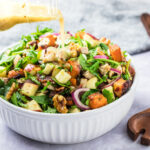 Warm Spinach Salad Recipe Author: Mark's Daily Apple
Warm Spinach Salad Recipe Author: Mark's Daily Apple  Total Time: 50 minutes
Total Time: 50 minutes  Yield: 4 servings [image error] Print Recipe [image error] Pin Recipe Description
Yield: 4 servings [image error] Print Recipe [image error] Pin Recipe Description This Warm Spinach Salad is very versatile and customizable! It’s high in protein and loaded with colorful and nutrient-dense veggies and healthy fats. Roughly chopping the greens ensures that you get bite-sized greens in every delicious bite.
Ingredients5 oz. baby spinach
5 oz. baby arugula
8 slices (about 6 oz) bacon
3 cups cubed butternut squash
1 red onion, thinly sliced
1/3 cup roughly chopped walnuts
1 lb. shredded or chopped chicken
4 hard-boiled eggs, peeled and sliced or quartered
1/4–1/3 cup Primal Kitchen Honey Mustard Dressing
Optional: 1 chopped apple
Optional: 4 oz. goat cheese
InstructionsPreheat your oven to 375 degrees Fahrenheit (190 degrees Celsius).
Lay your bacon out on a rimmed sheet pan and bake it in the oven until it reaches your desired crispiness. This will probably take about 20 minutes, but start checking after 15. Use tongs to remove the bacon to a towel-lined plate. When it is cool enough to handle, roughly chop the bacon and set it aside.
Meanwhile, carefully toss the cubed butternut squash in the bacon fat in the baking sheet. Arrange the butternut squash in a single layer, then place the pan back in the oven and roast for 20 minutes. Flip the squash over and bake for an additional 5 to 10 minutes, or until the squash is golden. Place the squash in a bowl large enough to toss all the salad ingredients.
Add the chopped bacon back to the pan and place the pan back in the oven for a few minutes to get the bacon warm again. While the bacon is warming, roughly chop the baby spinach and arugula leaves in batches so they’re in bite-sized pieces.
Add the warm bacon, sliced onion, walnuts, chicken, and apple and/or cheese if you’re adding them to the bowl with the squash. Gently toss the ingredients with the Primal Kitchen Honey Mustard Dressing.
Add the chopped greens and egg and gently toss so everything is combined. As you toss the salad together, the arugula and spinach will wilt slightly. Enjoy right away or save leftovers for the next day.
NotesYou can use chopped roasted chicken breast, leftover chicken, a rotisserie chicken, or whatever protein you’d like.
To keep it lower in carbs, you can use turnips or radishes in lieu of butternut squash.
While mixing the greens in with the warm elements will slightly wilt them, you can also lightly sauté the greens prior to adding them to the mixing bowl if you’d like!
 Prep Time: 15 minutes
Prep Time: 15 minutes Cook Time: 40 minutes
Cook Time: 40 minutes Category: Salad Nutrition Serving Size: 1/4 of recipe Calories: 446 Fat: 25 grams Carbohydrates: 22 grams Fiber: 5 grams Protein: 35 grams Net Carbs: 17 grams
Category: Salad Nutrition Serving Size: 1/4 of recipe Calories: 446 Fat: 25 grams Carbohydrates: 22 grams Fiber: 5 grams Protein: 35 grams Net Carbs: 17 grams Keywords: spinach salad, butternut squash, warm salad
 Did you make this recipe?
Did you make this recipe? Share a photo and tag Mark's Daily Apple — we can't wait to see what you've made!
(function($) { $("#dfiG7TD").load("https://www.marksdailyapple.com/wp-ad..." ); })( jQuery ); 
The post Warm Spinach Salad Recipe appeared first on Mark's Daily Apple.


March 25, 2022
New and Noteworthy: What I Read This Week—Edition 170

Research of the Week
Artificial sweeteners have faint links to increased cancer risks.
COVID seems to increase the risk of diabetes.
Africans were eating olives 100,000 years ago (at least).
In middle adulthood, raising HDL and lowering blood sugar seems to reduce the risk of Alzheimer’s. Now, how does one do that?
Minerals are important but balance is vital.
New Primal Kitchen PodcastsMedia, SchmediaLockdowns made childhood obesity significantly worse.
How permanent daylight savings would affect sunrise and sunset across the country.
Interesting Blog PostsPhinney and Volek on keto and heart health.
Social NotesEverything ElseBody temperature and lifespan.
“… higher neuroticism was related to an older subjective age, whereas higher extraversion, openness, agreeableness, and conscientiousness were associated with a younger subjective age.”
Things I’m Up to and Interested InIt’s about time: People are finally catching on to the industrial seed oil scourge.
I’m not surprised: Conflicts of interest as far as the eye can see.
Interesting comic: The hanged man.
I understand: Top tennis player Ash Barty is quitting at the top of her game.
Good news: Robust immunity sustained a year and a half after natural infection with COVID.
Question I’m AskingWould we be better off—overall—without modern technology?
Recipe CornerBeef enoki mushroom rolls—a great appetizer.Coconut jelly.Time CapsuleOne year ago (Mar 19 – Mar 25)
This is Why Your Pullups Aren’t Working — Fix them.How to Turn a Burger into the Perfect Food — How to do it.Comment of the Week
“I love the pictures of old Ireland. Especially the first one with all of the barefoot children. Pause, look at the surroundings and then into the faces of each of those kids – a wonderful dose of perspective and inspiration.”
-It’s amazing what you can see in an image, Guy.
(function($) { $("#dfWi8gb").load("https://www.marksdailyapple.com/wp-ad..." ); })( jQuery ); 
The post New and Noteworthy: What I Read This Week—Edition 170 appeared first on Mark's Daily Apple.


March 23, 2022
Primal Guide to Bulking
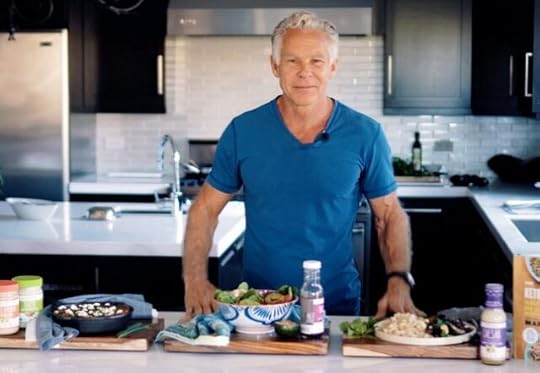
So you want to gain some weight, some mass. You want more muscle. You want to bulk up. And you want to do it in a healthy way within the context of the Primal Blueprint, but aren’t sure where to start. Most popular bulking advice consists of eating everything in sight—dirty bulking with fast food, TV dinners, PB&J, peanut butter on the spoon, whatever you have on hand. That’s not the way, folks.
As I’ve made pretty clear, our ultimate goal is to achieve positive gene expression, functional strength, optimum health, and extended longevity. In other words: To make the most out of the particular gene set you inherited. These are my end goals, and I’ve modeled the Primal Blueprint Laws with them in mind. But that doesn’t mean packing on extra muscle can’t happen with additional input. After I retired from a life of chronic cardio and started living Primally, I added 15 pounds of muscle, while keeping low body fat levels without really trying, so it’s absolutely possible for a hardgainer to gain some. The question is how much and at what expense?
I’d be the first to tell you that lean body mass is healthier than adipose tissue. Generally, the more lean mass a person has, the longer and better they live. But to increase mass at the expense of agility, strength, or speed, or health is, in my opinion, counterproductive.
Of course, we’re all built a little differently. The basic building blocks are the same in everyone, but sexual reproduction (as opposed to asexual reproduction) has the funny habit of producing unique genetics and small variations that affect the way we respond to our environments. It’s why some people are short and some are tall, or why some of us respond better to carbohydrates than others. Even though we all pretty much operate the same way, there IS a range of possible outcomes that is proscribed by your direct ancestors. Some people naturally have more muscle mass. Some people are innately more muscular than the average person, and putting more on through resistance training is often an easy task. Then there are those who can’t seem to gain a pound: the hardgainers. They might be increasing strength, but it happens more slowly and doesn’t seem to translate into visible muscle mass.
There is a genetic ceiling for muscle growth (and overall size gain). The ceiling manifests in all sorts of ways—your appetite, your hypertrophy response to resistance training, your motivation to train—but there is a ceiling. And although it can be circumvented with pharmacological interventions and force feeding, the Precautionary Principle suggests that using supranatural tactics to overcome the genetic ceiling will have negative effects on health.
How to Bulk the Right WayMost people do not hit their genetic potential, however. If you’re reading this, there’s likely much more you can do to fulfill your genetic potential and “bulk up.” You can “bulk” in a healthy way. You can bulk in a natural way. You can bulk in a way that flows with your genetic inclinations and potential.
Eat Lots of Plants and AnimalsCalories count. You have to eat more food than you are eating before. You have to eat more food than you previously considered excessive before, because you’ll also be lifting weights and creating more of an energy demand. There’s no way around it. You must eat lots of nutrient-dense plants and animals.
Steaks, ground beef, chops, roasts, whole chickens, slabs of salmon, cod filets, mussels, shrimp.
Fruit, greens, crucifers, asparagus, tubers, roots, squash, berries.
Eat it all, and eat lots of it.
Count ProteinThe only thing you should explicitly count is protein grams. Aim for a gram of animal protein per pound of body weight. It’s okay if you go a bit under or a bit over.
Overeat on Training DaysYou can find detailed guides to determining the specific number of calories you need to be eating to gain mass, but I don’t really agree with following those strict guidelines unless you’re being paid to gain weight. Instead, the better way to ensure you’re eating enough calories to gain weight but not so many that you’re also getting fat is to overeat only on training days and not on rest days.
How does this look?
Stuff yourself—within reason—on training days. Lift hard and then eat big. If you train hard enough, “stuffing yourself” shouldn’t take much effort. It’ll just happen naturally.
Eat normally on rest days. Again, this should ensue naturally. If you eat enough food on training days, your body won’t need as many calories on rest days. This will give you a “break” and allow both muscle protein synthesis and fat loss to occur.
Eat Carbs and Protein Around Your WorkoutsCarbs help you gain weight. This cannot be disputed. They aren’t necessary for muscle gain, but they can certainly make it easier for many people.
Protein is absolutely essential. There’s no way around eating animal protein (unless you want to spend your days mixing and weighing arcane plant sources of protein to hit the perfect blend that only barely approaches simply eating a piece of meat or a bowl of eggs or a whey shake).
Eating both protein and carbs shortly before or after your workouts will take advantage of the “anabolic window”—a diffuse opportunity where dietary glucose is more likely to become muscle glycogen and protein is more likely to become muscle. Carbs are actually more crucial to get the timing right; protein is okay eaten several hours after.
Emphasize Carbs and Protein on Workout Days, Fat and Protein on Rest DaysThis isn’t a strict prescription. This doesn’t mean “no fat” on workout days and “zero carbs” on rest days. It just means that since you’ll be eating more carbs on hard training days you shouldn’t go overboard with fat. And since you’ll be eating more fat on rest days you shouldn’t go overboard with carbs. Remember: we’re going for a clean, lean bulk, not a dirty bulk that makes you fatter.
Lift Hard and LongThis is subjective and malleable. Lifting hard can take many forms, some of which I’ll explain in another section down below. But the point is to work really, really hard. To bring your musculature to just shy of its breaking point. Go to failure, or almost.
Some people do this with super slow lifts, where each rep takes five to ten seconds to complete (or even more).
Some people do this with super heavy lifts and fewer reps, where each set is smaller but the effort you’re giving is maximal.
Some people do this with lighter weights and higher reps, collecting a lot of volume.
In each of these instances, you’re accumulating a lot of muscular tension. You’re giving your all. You’re bringing your muscles to the brink.
However, sets of 8-12 reps seems to be the best range for gaining mass (and strength). Whatever rep scheme you choose, pick a weight that feels hard by the time you reach the end of the set. You should have to really push to finish.
Chase True HungerTo bulk, you need to achieve true hunger. There’s the hunger you get because you lifted some heavy weights. The kind that feels pure, raw, real, and unmistakable and unignorable. This is honest hunger. This is hunger that wants to replete your glycogen and introduce the protein and micronutrients required to maximize muscle protein synthesis. It’s the feeling of emptiness after a lifting session, a vacuum that must but probably cannot be filled.
You need to listen to this hunger. It’s trustworthy. It’s urgent. And it involves salivation—you can feel it in your bone marrow.
Control CortisolCortisol is catabolic. Cortisol contradicts testosterone. Cortisol is the major stress hormone, and it exists for a very legitimate reason—dealing with “flight or fight” incidents, inadequate sleep, anxiety—but in large amounts cortisol increases serum amino acids by breaking down muscle, inhibiting protein synthesis, and reducing amino acid uptake by the muscles.
Your cortisol:testosterone ratio response to a resistance training session can predict how much muscle you’ll gain (or not).https://pubmed.ncbi.nlm.nih.gov/33804... A lower ratio is better for gains and, thus, for healthy bulking. Furthermore, elevated chronic cortisol is linked to fat accumulation, so while elevated cortisol may make you gain weight, it won’t be the weight you want.
How do you limit cortisol?
Adequate sleepAdequate caloriesEating the carbs you earn—if you earned carbs/burned glycogen during training, you should just eat a piece of fruit or a potato rather than manufacture glucose from proteinKeep your intense workouts short and intense—long, drawn out training sessions over 60+ minutes will run the risk of tipping the cortisol:testosterone balanceUse smart supplementation—I created Adaptogenic Calm to reduce cortisol from excessive training, and it quickly became a hit among my athlete peers; I still use it to this day to enhance recoveryFigure out some way to “meditate“—for me it’s paddle boarding and walking my dogSkip “Cardio,” Take WalksIf you’re going for pure bulk, traditional cardio is counterproductive. Instead, just take daily walks. Walk after you train (to burn the liberated free fatty acids). Walk on rest days (to keep the blood and lymph flowing and speed recovery). You can do do easy aerobic “running,” as long as you keep your heart rate under 180 minus your age and maintain nasal breathing and keep things low-stress.
Don’t run hard. Don’t train for a marathon or 10k while you bulk. Again, you can do these things while resistance training and see results, but if you’re only interested in bulking up, any significant amount of cardio will negate your gains.
Sleep More Than You ThinkSleep is where the magic happens. It’s where fat loss occurs and muscle protein synthesis engages. Sleep is when you actually gain. Sleep debt actively inhibits muscle recovery and hypertrophy and promotes muscle degradation.https://www.ncbi.nlm.nih.gov/pubmed/2... Sleep deprivation increases cortisol and reduces testosterone; for optimal muscle building, the former should be lower and the latter higher.https://www.ncbi.nlm.nih.gov/pubmed/2... One older study found that total sleep deprivation increased urinary excretion of nitrogen, which could be indicative of muscle breakdown and loss of lean mass.https://ajcn.nutrition.org/content/19...
Furthermore, inadequate sleep impairs many important factors tangentially related to bulking:
Worse insulin sensitivity (affects your ability to assimilate nutrients and burn fat)Worse balance (makes you more likely to injure yourself working out)Sleep at least 8 hours a night.
Don’t Fast
Fasting and bulking don’t really mesh well. Fasting is a way to reduce calorie intake; bulking is a goal that requires increased calorie intake. Sure, you can mess around with enormous meals and sprinkle protein power in everything and take shots of olive oil to get those calories up quick, but the vast majority of people will have trouble bulking while fasting.
If you want to “fast,” I’d recommend a “sunshine eating window.” Only eat when the sun is up, and abstain from food when it’s not. This will give you a larger eating window for higher calorie intakes while also giving you plenty of time not eating, so you can digest your food, sleep, and burn more body fat.
Either that or do the “Leangains” method, where you use a shortened eating window and shift your macro ratios depending on training status to make “lean gains,” or gain lean mass and minimize or abolish fat gain:
A daily 16 hour fast during which you eat nothing containing calories. Coffee, tea, and other non-caloric fluids are fine. Some people get away with a little cream in their drink.A daily 8 hour eating window.Three days of weight training, ideally performed at the tail end of the fasting period. To improve performance and muscle protein synthesis, you have the option of consuming 10 grams of branched chain amino acids or some whey isolate 10 minutes before the workout.Always eat high protein.On training days, eat more carbs and less fat.On rest days, eat more fat, fewer carbs, and slightly reduce calories.Most people begin their fast after dinner (say, 9 PM), workout in the afternoon (at around 12 PM), and break their fast immediately post-workout (at around 1 PM), but you can use any schedule you prefer as long as you hit the 16 hours of fasting.Your post-workout meal should have about 50% of your day’s caloric allotment (a real feast).This works pretty well but you have to be religious/neurotic about it. If you’re the right temperament, it might be good for you.
Active VisualizationMindful engagement and activation of the muscles will improve hypertrophy and increase muscle gain by directing more bodily resources to the muscle. When you lift a weight, actively feel the muscle contracting. Imagine with vivid imagery the muscle tissue lengthening and then contracting.
Here’s an example. When I do rows, I think of a few things. One is the cue to “shoot elbows back.” Another is to “bring my shoulder blades toward each other.” And finally, I think about, imagine, and feel the contraction of the sheaths of muscle across my upper back, paying attention to the sensation of tension in those areas, the burn of engaged musculature. When you do that active kind of visualization, you are strengthening the connection between brain and muscle tissue and enhancing the anabolic effect.
Feel the BurnThe “burn” you get while lifting weights indicates that you’ve reached levels of intensity adequate enough for a strong anabolic response. This isn’t really scientific, per se, but all my years of training (and training others) agree. You should hit the “burn” at least once every workout or exercise.
Try Blood Flow Restriction TrainingBlood flow restriction training, or BFRT, involves inhibiting the flow of blood from the heart to the limbs by wrapping an elastic wrap around the upper legs and/or arms (depending on the workout). By wrapping the limbs and using a lower weight and higher volume than normal (30% of 1 rep max and 15-30 reps, respectively), you simulate a “hypoxic” environment in the muscle tissue and promote the development of type 2 muscle fibers. The idea is that BFRT allows trainees to make good gains without having to lift heavy weights, which many older adults are nervous about trying.
Most research suggests that blood flow restriction training with lighter weights is just as effective as heavier weight training for increasing muscle strength and size.https://pubmed.ncbi.nlm.nih.gov/32031...
Include Important Supplementary FoodsChicken breast, broccoli, and brown rice won’t cut it. Many specific supplementary foods exist that provide vital anabolic compounds. I’ll list as many of them as I can think of:
Whole eggs—Provide choline, cholesterol, vitamin A, protein, iron, zinc, and arachidonic acid; extra points for eating fertilized eggs, which can inhibit myostatin (an enzyme that limits muscle growth). Eat daily. And do not just eat the whites, as whole eggs work better even when you control for protein content.Liver—Provides choline, vitamin A, protein, zinc, and iron (liver and eggs were an old school bodybuilder classic and vitamin A is the “forgotten bodybuilding nutrient“). Eat once a week.Seafood—Provides creatine, protein, omega-3s (increase muscle protein synthesis)https://academic.oup.com/ajcn/article.... Eat three times a week.Oysters—Zinc and iron powerhouses. Eat twice a week.High protein dairy, ideally raw or fermented—When you lift weights, you need calcium and protein and saturated fat and all the other components of dairy to grow. After all, dairy is meant to grow mammalian tissue.Red meat on the bone—There’s something especially anabolic about eating meat off a bone. Maybe it’s the gelatin providing substrate to support connective tissue health. Maybe it’s the Primal high-T response to gnawing on bones. Whatever it is, it works.Purple sweet potatoes—The right blend of taste, anthocyanins, fiber, texture, and glucose. Great post-workout.Pineapple—Speeds up muscle recovery, tastes great. Excellent post workout.Include Helpful SupplementsWhey isolate—The best pound for pound animal protein on the planet. Shown time and time again to improve hypertrophy. 10-20 grams morning and night (or post workout).
Creatine—Enhances muscular performance and hypertrophy regardless of timing https://pubmed.ncbi.nlm.nih.gov/34610... 5 grams a day.
Beta-alanine—Another supplement that increases muscle carnosine content and the amount of work you can do, the number of reps you can eke out. Beware that beta-alanine will give you an intense prickly feeling in your limbs, but it’s totally safe. 6 grams a day.https://jissn.biomedcentral.com/artic...
Collagen—Bulking requires a lot of resistance training, which increases the demands on your connective tissue. Collagen is a great way to rebuild and reinforce ligaments, tendons, and cartilage.
Take It SlowMost importantly, you have to just let the bulk happen the way it wants to. Put everything into place—the food, the supplements, the sleep, the stress reduction, the exercises, all the tips from this post—and let it ride. A bulk isn’t linear. It doesn’t follow any schedule. You might not gain for a week and then suddenly pick up 5 pounds. The body works in mysterious ways, in fits and starts, stalls and bursts. Trust that it knows what it’s doing.
The worst thing you can do is stress about not gaining as fast as you wanted to gain. That’s when you get sloppy, when you get injured, when you neglect the less-than-sexy things that are just as important as lifting big weights and eating big meals.
That’s it: the Primal guide to bulking.
Do you “bulk?” What’s your method? How have you done it in the past? What would you add?
Thanks for reading.
(function($) { $("#dfJdXo3").load("https://www.marksdailyapple.com/wp-ad..." ); })( jQuery ); 
References https://pubmed.ncbi.nlm.nih.gov/33804259/https://www.ncbi.nlm.nih.gov/pubmed/21550729https://www.ncbi.nlm.nih.gov/pubmed/23046906https://ajcn.nutrition.org/content/19/5/313.abstracthttps://pubmed.ncbi.nlm.nih.gov/32031709/https://academic.oup.com/ajcn/article/93/2/402/4597703https://pubmed.ncbi.nlm.nih.gov/34610729/https://jissn.biomedcentral.com/articles/10.1186/s12970-018-0224-0
The post Primal Guide to Bulking appeared first on Mark's Daily Apple.


March 22, 2022
Dear Mark: Colostrum
For today’s Dear Mark, I’m answering a reader question about whether colostrum supplements are worth trying. Let’s get right into it.
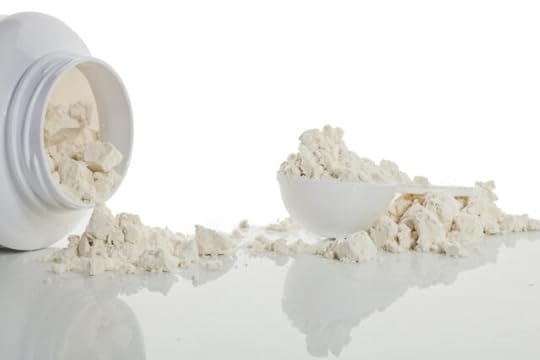
Dear Mark,
A buddy of mine has been taking colostrum powder for a few months now. He swears it’s helping him bulk up in the gym. I’m training for a century ride this summer and he says I should start using colostrum for leg strength. Ever since he mentioned it I feel like I’m seeing more fitness types talking about it on social media too. I’d love to get your take before shelling out the money. Thanks Mark!
Ah yes, your phone heard you talking about colostrum. Now your social media feed is full of colostrum posts, and you want to know if it’s legit or just another empty promise.
Colostrum, as you might know, is the “first milk” that mammals produce in the two to three days after giving birth. Compared to regular milk, colostrum is particularly rich in antibodies, enzymes, growth factors, and other nutrients all designed to protect the newborn and kickstart their immune system and digestion. If you were breastfed at birth, you received colostrum from your mother. Colostrum that you buy as a supplement is almost always bovine (cow) colostrum, usually in powder or capsule form.
Because of all the good stuff colostrum contains, it is a hot research topic for medical applications and boosting athletic performance. I’ll highlight some of the interesting findings in both areas here.
Does Bovine Colostrum Boost Athletic Performance?Athletes are always looking for that edge. I can see why colostrum, which contains protein, growth factors like IGF-1, and lots of vitamins and minerals, would seem promising. After all, those compounds do support muscle growth, bone health, and general fitness. It’s also why some athletes have apparently tried drinking human breastmilk as a performance enhancer. (Breastmilk, although also loaded with nutrients, is not the same as colostrum.)
However, just because a product contains beneficial components doesn’t mean our bodies can use them as desired. In this case, adult humans don’t seem to be able to absorb the IGF-1 in bovine colostrum.https://pubmed.ncbi.nlm.nih.gov/31123... Baby cows can absorb it because their intestines are more permeable, but we cannot.
That doesn’t mean there aren’t any benefits for athletes. I’m merely pointing out that just because something seems on face value like it should confer certain benefits doesn’t necessarily mean it will. That’s why we have research studies.
Before turning to the research, remember that when we ask, “Does supplement X boost athletic performance?” we also need to ask, “Compared to what?” In this case, researchers usually compare colostrum to whey protein. This makes sense. The benefits of whey protein are already well known. Pitting whey against colostrum in a single study design lets us see if a particular effect is due to protein ingestion generally or whether colostrum confers an extra advantage.
So what do the studies show?
Colostrum for Athletes: The DataIt’s a mixed bag of results, partially due to variation between study designs and relatively small study groups. In terms of positive outcomes:
Older adults supplemented with colostrum (60g/day) or whey protein and did resistance training three times per week. After eight weeks, both groups increased upper body strength, muscle mass, cognitive function, and muscle thickness. The colostrum group also improved leg press strength and reduced bone resorption.https://pubmed.ncbi.nlm.nih.gov/24281... healthy adults took either colostrum (20g/day) or whey protein for eight weeks. All participants already did resistance training at least three times a week. They were instructed not to change their normal diet or exercise routines. Participants in the colostrum group gained an average of 1.5kg of lean mass according to DEXA scans, whereas the whey protein group stayed the same.https://pubmed.ncbi.nlm.nih.gov/11312... a small study of ten trained male cyclists, those who took 10 grams of colostrum daily for eight weeks maintained testosterone levels and heart rate variability during a five-day race.[ref]https://pubmed.ncbi.nlm.nih.gov/23903529/">3Taking 60 grams per day of colostrum for nine weeks improved female rowers’ ability to buffer lactate from the bloodstream (which can delay time to fatigue and support post-exercise recovery), but it did not bolster performance on a rowing test.https://pubmed.ncbi.nlm.nih.gov/12432... male and female elite field hockey players took colostrum (60g/day) for eight weeks, their sprint performance improved significantly compared to athletes who took whey. However, there were no significant differences in endurance performance or body composition.https://pubmed.ncbi.nlm.nih.gov/12500...While these studies are promising, plenty of studies show no particular benefit of colostrum relative to whey. A comprehensive literature review by the folks at Examine turned up no advantages for colostrum in terms of VO2max, anaerobic running capacity, heart rate during exercise, or lactate threshold.https://examine.com/supplements/colos...
My takeaway is that in terms of performance, the benefits of colostrum are more or less on par with whey protein. It might have a slight advantage in some cases, but based on the research done so far, colostrum doesn’t appear to be the next wonder supplement. I also don’t see any downsides to experimenting with it aside from the cost. At worst, you’ll get the same benefits you get from supplementing with whey protein.
Health Benefits of Colostrum SupplementationWhere colostrum may shine is in helping athletes stay healthy. Specifically, the immune factors in colostrum—especially lactoferrin and IgG—may confer protection in humans. The (surprisingly extensive) research probably deserves its own post, but I’ll briefly touch on a few areas of particular relevance to athletes.
First, colostrum could help counter athletes’ increased susceptibility to upper respiratory infections due to immunosuppression from excessive training. https://www.tandfonline.com/doi/full/... A 2016 review of five studies concluded that colostrum supplementation reduces the risk of upper respiratory infection by 38 percent, at least in the athlete populations studied.https://www.ncbi.nlm.nih.gov/pmc/arti...
Second, endurance athletes especially seem to be prone to gut issues. Colostrum might help.https://www.sciencedirect.com/science... I’ve had readers tell me they’ve had great success with using colostrum to address IBS-type symptoms. There’s also evidence that colostrum mitigates the gut permeability that normally accompanies exercising in the heat.https://pubmed.ncbi.nlm.nih.gov/24200...
If you’re an athlete who’s popping NSAIDs to keep pain at bay so you can keep hitting the road or the turf, colostrum supplementation might help offset some of the damage you’re doing to your gut lining.https://pubmed.ncbi.nlm.nih.gov/11352... I can’t stress, though, that the better course of action would be to modify your workouts and find other ways to reduce or manage pain if possible.
Bovine Colostrum Supplement Recommendations: Dosing and TimingApparently for maximum absorption, you want to take colostrum on an empty stomach. If you are using powdered colostrum (not capsules) mixed with water, some of the colostrum will be absorbed directly through the mouth, which some people believe is beneficial for immunity.
There’s no standard dose from what I can tell. The studies I looked at gave participants somewhere between 10 or 20 grams per day on the low end and 60 grams per day on the high end, but I’ve heard of people taking much more. I see no obvious risk from taking a higher dose (but talk to your doctor et cetera).
Bovine Colostrum Risks?None that I can tell except perhaps if you don’t tolerate dairy. Colostrum does contain some casein and lactose, so tread carefully if you’re sensitive to those.
The Bottom Line
For athletic performance, the main benefits of colostrum probably come from the protein, meaning you’ll do just as well taking whey protein. I see no reason not to try colostrum if you’re interested, though. The research into the other health benefits of bovine colostrum is intriguing. If I was dealing with persistent upper respiratory infections or symptoms of intestinal permeability, I’d be asking to my doctor about colostrum.
If you’ve had a good (or bad) experience with bovine colostrum in the past, I’d like to hear about it. Tell me in the comments.
References https://pubmed.ncbi.nlm.nih.gov/31123862/https://pubmed.ncbi.nlm.nih.gov/24281841/https://pubmed.ncbi.nlm.nih.gov/11312068/[/ref]In a small study of ten trained male cyclists, those who took 10 grams of colostrum daily for eight weeks maintained testosterone levels and heart rate variability during a five-day race.[ref]https://pubmed.ncbi.nlm.nih.gov/23903529/https://pubmed.ncbi.nlm.nih.gov/12432178/https://pubmed.ncbi.nlm.nih.gov/12500989/https://examine.com/supplements/colostrum/#effect-matrixhttps://www.tandfonline.com/doi/full/10.1080/09540105.2021.1892594https://www.ncbi.nlm.nih.gov/pmc/articles/PMC4960812/https://www.sciencedirect.com/science/article/pii/S2352364621000249https://pubmed.ncbi.nlm.nih.gov/24200023/https://pubmed.ncbi.nlm.nih.gov/11352778 (function($) { $("#dfXXW2G").load("https://www.marksdailyapple.com/wp-ad..." ); })( jQuery );
The post Dear Mark: Colostrum appeared first on Mark's Daily Apple.


March 21, 2022
Philly Cheesesteak (with Optional Primal Cheddar Cheese Sauce)
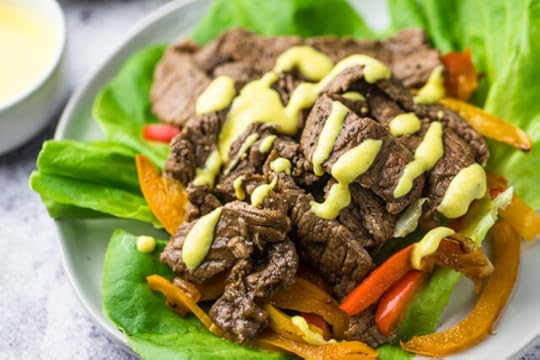 Savory, smokey, and dripping with creamy cheese, the Philly cheesesteak is an iconic loaded sandwich made traditionally with beefsteak, a hoagie roll, and oodles of melted cheese. We skipped the roll and redid the cheese sauce recipe for a Primal take on this Pennsylvania local favorite! Not totally authentic, granted, but delicious nonetheless.
Savory, smokey, and dripping with creamy cheese, the Philly cheesesteak is an iconic loaded sandwich made traditionally with beefsteak, a hoagie roll, and oodles of melted cheese. We skipped the roll and redid the cheese sauce recipe for a Primal take on this Pennsylvania local favorite! Not totally authentic, granted, but delicious nonetheless.
You really can’t go wrong with thinly sliced steak topped with caramelized onions, sautéed mushrooms, and peppers. Sear the thinly sliced steak for only a minute, sauté the mushrooms and peppers until tender, and cook the onions until brown and sweet.
Pile it all high on plate—Philly cheesesteak isn’t about dainty serving sizes—and enjoy!
What Cheese Is on Philly Cheesesteak?Different chefs might put their own spin on it, but cheesesteaks usually feature American, provolone, or even Cheez Whiz. We made our sauce here from sharp cheddar cheese, Primal Kitchen Dijon Mustard, and heavy cream. You can forget about making cheese sauce and just melt a slice of really good cheddar or aged provolone on top, or skip the cheese sauce if you don’t tolerate dairy.
How to Make a Philly CheesesteakServes: 8
Time in the Kitchen: 1 hour
IngredientsMeat:
3 Tbsp Primal Kitchen Avocado Oil1 Tbsp butter1 onion, sliced2 lbs. (900g) boneless ribeye steaks (see Notes)8 oz. sliced mushrooms3 bell peppers (any color), slicedSalt and pepperButter lettuce leaves, optionalPrimal Cheese Sauce:
½ cup heavy cream or coconut milk5 oz. shredded sharp cheddar cheese½ Tbsp Primal Kitchen Dijon Mustard (or Spicy Mustard)Pinch of turmeric powder
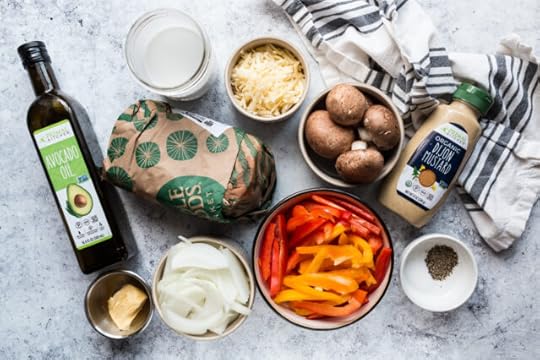
Before beginning to cook, place the steaks in the freezer for about 30 minutes. This will help them firm up so they can be sliced.
Heat the butter in a skillet over medium heat. Once hot, add the onions and peppers. Sauté for around 10 minutes or until they are very soft and the onions are beginning to caramelize. Remove the veggies from the pan.

Take the steaks out of the freezer and thinly slice them against the grain. Toss the slices in salt and pepper. Add 2 tablespoons of oil to the pan on the stovetop over medium-high heat. Once hot, add the steak to the pan and brown for about 30 to 45 seconds before giving them a stir and browning again on the other side. You want them to be cooked very quickly so they don’t overcook and get tough. It’s okay if the steak is still pink in the middle! Remove the steak slices from the pan and set aside.
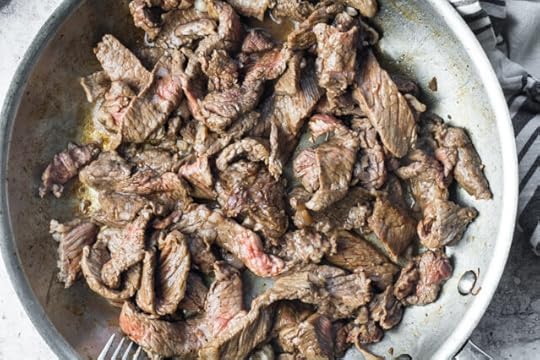
Add the remaining oil to the pan and add the mushrooms. Sauté until the mushrooms are soft, then set the mushrooms aside. There will probably be a little liquid in the pan after the mushrooms have cooked. Heat the pan over medium heat and reduce any liquid in the pan, then toss the steak slices back in the pan to warm them, and season with salt and pepper to taste.
Place the steak and veggies on a plate or on butter lettuce leaves.
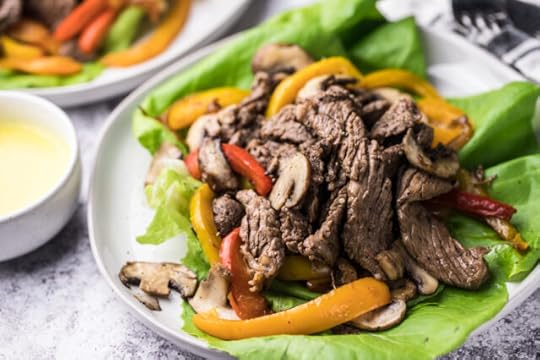
To make the cheese sauce, pour the cream/milk into a small saucepan over medium heat. Stir frequently to help it warm and to keep it from burning at the bottom of the pan. Let it bubble and cook for a minute or so, then add the mustard and pinch of turmeric. Keep stirring until the sauce thickens.

Once the sauce is bubbly and has thickened, turn off the heat and quickly add in the shredded cheese a bit at a time as you continue stirring. Continue stirring until the cheese has fully melted. Drizzle the sauce over your steak and enjoy!

Nutrition Info (1/8 of meat and cheese sauce):
Calories: 532
Fat: 45 g
Saturated Fat: 21 g
Carbs: 6 g
Net Carbs: 5 g
Protein: 24 g
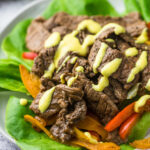 Philly Cheesesteak (with Optional Primal Cheddar Cheese Sauce) Author: Mark's Daily Apple
Philly Cheesesteak (with Optional Primal Cheddar Cheese Sauce) Author: Mark's Daily Apple  Total Time: About 1 hour
Total Time: About 1 hour  Yield: 8 servings Diet: Gluten Free [image error] Print Recipe [image error] Pin Recipe Description
Yield: 8 servings Diet: Gluten Free [image error] Print Recipe [image error] Pin Recipe Description Savory, smokey, and dripping with creamy cheese, the Philly cheesesteak is an iconic loaded sandwich made traditionally with beefsteak, a hoagie roll, and oodles of melted cheese. We skipped the roll and redid the cheese sauce recipe for a Primal take on this Pennsylvania local favorite!
Ingredients Meat:3 Tbsp Primal Kitchen Avocado Oil1 Tbsp butter1 onion, sliced2 lbs. (900g) boneless ribeye steaks8 oz. sliced mushrooms3 bell peppers (any color), slicedSalt and pepperButter lettuce leaves, optionalPrimal Cheese Sauce:½ cup heavy cream or coconut milk5 oz. shredded sharp cheddar cheese½ Tbsp Primal Kitchen Dijon Mustard (or Spicy Mustard)Pinch of turmeric powder InstructionsBefore beginning to cook, place the steaks in the freezer for about 30 minutes. This will help them firm up so they can be sliced.
Heat the butter in a skillet over medium heat. Once hot, add the onions and peppers. Sauté for around 10 minutes or until they are very soft and the onions are beginning to caramelize. Remove the veggies from the pan.
Take the steaks out of the freezer and thinly slice them against the grain. Toss the slices in salt and pepper. Add 2 tablespoons of oil to the pan on the stovetop over medium-high heat. Once hot, add the steak to the pan and brown for about 30-45 seconds before giving them a stir and browning again on the other side. You want them to be cooked very quickly so they don’t overcook and get tough. It’s okay if the steak is still pink in the middle! Remove the steak slices from the pan and set aside.
Add the remaining oil to the pan and add the mushrooms. Sauté until the mushrooms are soft, then set the mushrooms aside. There will probably be a little liquid in the pan after the mushrooms have cooked. Heat the pan over medium heat and reduce any liquid in the pan, then toss the steak slices back in the pan and season with salt and pepper to taste.
Place the steak and veggies on a plate or on butter lettuce leaves.
To make the cheese sauce, pour the cream/milk into a small saucepan over medium heat. Stir frequently to help it warm and to keep it from burning at the bottom of the pan. Let it bubble and cook for a minute or so, then add the mustard and pinch of turmeric. Keep stirring until the sauce thickens. Once the sauce is bubbly and has thickened, turn off the heat and quickly add in the shredded cheese a bit at a time as you continue stirring. Continue stirring until the cheese has fully melted. Drizzle the sauce over your steak and enjoy!
NotesIf you want more cheese sauce, double the sauce recipe. I find a little of it goes a long way, but who doesn’t love more cheese?
If you don’t have ribeye steaks, you can use something like top round or sirloin. Keep in mind that you may need to add more fat to the pan while cooking leaner cuts of meat to keep the meat moist.
 Prep Time: 10 minutes
Prep Time: 10 minutes Cook Time: 45 minutes Nutrition Serving Size: 1/8 of recipe Calories: 532 Sugar: 3 g Sodium: 199 g Fat: 45 g Saturated Fat: 21 g Trans Fat: 0 g Carbohydrates: 6 g Fiber: 1 g Protein: 24 g Cholesterol: 103 mg Net Carbs: 5 g
Cook Time: 45 minutes Nutrition Serving Size: 1/8 of recipe Calories: 532 Sugar: 3 g Sodium: 199 g Fat: 45 g Saturated Fat: 21 g Trans Fat: 0 g Carbohydrates: 6 g Fiber: 1 g Protein: 24 g Cholesterol: 103 mg Net Carbs: 5 g  Did you make this recipe?
Did you make this recipe? Share a photo and tag Mark's Daily Apple — we can't wait to see what you've made!
(function($) { $("#dfGSVqT").load("https://www.marksdailyapple.com/wp-ad..." ); })( jQuery );
The post Philly Cheesesteak (with Optional Primal Cheddar Cheese Sauce) appeared first on Mark's Daily Apple.


March 18, 2022
New and Noteworthy: What I Read This Week—Edition 169

Research of the Week
Red meat is good for older people (and younger).
Using dairy to lose weight has better cardiometabolic effects than losing weight without dairy.
Dairy can improve zinc absorption.
Longitude within time zones and cancer risk.
Links between excessive napping and Alzheimer’s.
Monkeys in “fragmented forests” adapt to their surroundings by eating fewer calories and reducing activity.
New Primal Kitchen PodcastsPrimal Kitchen Podcast, Episode 22: Finessing the Role of the Fitness Coach With James Fitzgerald
Primal Health Coach: Stephanie Dodier has a non-diet approach to health.
Media, SchmediaNestle admits the obvious.
Interesting Blog PostsThe case for ditching daylight savings.
The link between high altitude living and longevity.
Social NotesProtein intake and kidney health: not what it might seem at first glance.
Everything ElseNew mouthguard tracks head hits in contact sports.
A tale as old as time: eggs are good.
Were all those “vaping-induced lung injuries” back in 2019 actually caused by undiagnosed COVID?
Things I’m Up to and Interested InImportant point many miss: Devices are designed to guide and hone your intuition.
One does wonder: Does meditation actually provide benefits?
Reminder: This is what the “experts” want you to eat to save the world and your health.
Interesting claim: That artificial intelligence will make humans more important in war, not less.
Simple relationship: More dietary and plasma magnesium, lower blood gluose.
Question I’m AskingDoes meditation work for you?
Recipe CornerPotato dominoes.Protein pancakes. Nice little treat.Time CapsuleOne year ago (Mar 12 – Mar 18)
Proper Squat Form: Common Mistakes You Might Be Making — Don’t make them.Is Fear of Success For Real? — Well, is it?Comment of the Week
“I’m so glad you wrote about the importance of not neglecting friendships. I have been meaning to contact a long-time friend that I haven’t seen in years. We had chatted last fall, and it’s been months since I last texted her. But your post motivated me to send her a quick message, and now we have a lunch date planned for next week! It’s all too easy to let weeks turn into months turn into years. Thank you, Mark.”
-Be like Daniela.
(function($) { $("#dflNSHH").load("https://www.marksdailyapple.com/wp-ad..." ); })( jQuery ); 
The post New and Noteworthy: What I Read This Week—Edition 169 appeared first on Mark's Daily Apple.


March 16, 2022
What to Do With That Box of Lemons
 Ever had the experience of your in-laws or neighbors or your CSA handing you a big box of lemons from their tree, and you’re left wondering what the hell you’re going to do with all these lemons. You might love lemons (who doesn’t?) and want to take advantage of this bounty that’s fallen into your lap, but you don’t know where to start. You’ve never faced a pile of lemons this large before. You’re flummoxed.
Ever had the experience of your in-laws or neighbors or your CSA handing you a big box of lemons from their tree, and you’re left wondering what the hell you’re going to do with all these lemons. You might love lemons (who doesn’t?) and want to take advantage of this bounty that’s fallen into your lap, but you don’t know where to start. You’ve never faced a pile of lemons this large before. You’re flummoxed.
Don’t do what most people end up doing and use a few here and there, letting the rest rot on the counter because you had no clue what to do. Instead, read on and find out how to preserve, store, and make the most of the lemons life gives you.
How to Store, Preserve, and Use LemonsFreeze them.The best way to quickly and easily store lemons long term is to freeze them whole.
Some people advocate washing the lemons first, but if they’re from a source you trust I don’t find it necessary. Plus, washing lemons prior to freezing means that you have to fully dry them or else you get icy lemons. Just brush off any obvious dirt and toss ’em in the freezer.
Whenever you need a lemon for anything, leave a frozen one on the counter to thaw. If you need one more quickly, simmer it in a covered pot until softened. The freezing actually ruptures the cell walls in the lemon, making them easier to juice. You’ll get more lemon juice out of a frozen-then-thawed lemon than you would from a lemon that’s never been frozen.
Freeze the juice in ice cube trays.This is more work, but you get very convenient lemon juice ice cubes.
To truly freeze lemon juice ice cubes, you need extremely cold temperatures. A standard freezer on your fridge might not cut it; they’ll still freeze, but it’ll be a little syrupy and gooey.
For smaller jobs, this is a great citrus juicer.
Dehydrate the rind.If you’re going to juice the lemons and freeze the juice, don’t waste the rind. Peel it with a vegetable peeler, then dehydrate the ribbons of lemon peel either in a food dehydrator, the oven on the lowest setting, or the warm sun.
One the rinds have all dried completely—they should cleanly snap in half, rather than bend—store them as is or grind into a fine powder. Store in an air tight container.
Lemon rind powder is excellent in salt and spice mixes, marinades, and salad dressings.
Make lemon vinegar.Another option for all those rinds is homemade lemon vinegar, a powerful, multipurpose DIY cleaning solution.
Make salted dried lemons.Boil about 12 cups of water with 2 cups of kosher salt dissolved in it. When it’s boiling, drop your lemons in and boil them for 5 minutes. Remove them from the water and place on drying racks.
If it’s hot out, let them dry outside. If it’s not, dry them on the lowest setting in your oven. It may take several days (oven) to a week (outside), but let them dry until they’re hard and crispy. Once they’re totally dry, you can add them whole to stews, break apart, or even grind and use in spice blends and rubs.
Dried salted lemons will last for years and provide a tangy, salty, umami earthiness to dishes.
Make preserved lemons.People have been preserving lemons using lactofermentation since at least the 12th century, which is when the first recipe was committed to writing, but they’ve probably been doing it even longer. Preserving lemons takes some elbow grease.
Cut each lemon into fourths without cutting all the way through. The four sections should still be attached together.Pour a tablespoon of kosher salt into each quartered lemon. Place in sterile jar.Really ram the lemons down so they all fit. Juice will gush out, mingle with the salt, and begin to fill the jar. This is what you want to happen.When all the lemons are crammed into the jar, add extra lemon juice until they’re all submerged.Shove a sprig of rosemary and a hot chili or two down into the jar between the lemons.Cover with a thin layer of olive oil and leave out on the counter to ferment for several weeks to several months. Taste as you go and when you like the taste and texture, stick in the fridge. Or don’t. Legend has it that Near Eastern and North African cultures would often leave the preserved lemons out at room temperature for years.To enjoy preserved lemons, make use of everything: The juice is great in marinades and salad dressings. The lemons themselves are excellent in marinades, stews, salads, and when cooking fish. You can leave the lemons whole or blend the entire jar up and use the preserved lemon paste as needed.
Use them in ways you didn’t think possible.Most people just don’t have any creativity when it comes to using lemons.
Squeeze fresh juice over freshly cooked steak or lamb. It’s delicious.Add lemon juice to a tall glass of Gerolsteiner sparking mineral water with a dash of salt. Great morning pick me up or overall hydrator.Use the juice in place of vinegar. Salad dressings, recipes, marinades, etc.Grill asparagus (or any vegetable, really) and toss in olive oil and lemon juice. Finish with salt.Fresh lemon juice is a killer finisher for homemade gravy. Cuts through the richness.Take an avocado, a can of sardines, maybe some smoked oysters, and lemon juice. Mix it and mash it all together, then eat.Put a whole lemon inside your chicken when it roasts. Cook veggies and tubers in the pan juices midway through.Make ceviche. Lots of lemon juice, salt, onions, garlic, chili peppers, and fish marinated until the fish “cooks.”If you eat legumes, a chickpea salad is a fantastic meal. Chickpeas, sardines or chicken, lemon juice, olive oil, salt. Stir to mix, consume.Lemon juice with water at a 1:1 ratio soothes a sore throat.Make lemonade.Yes, you can make healthy lemonade that doesn’t involve any sugar or artificial sweeteners at all. All you need:
Juice from 1-2 lemons.Sparkling mineral water. I recommend Gerolsteiner or Topo Chico.Inositol and glycine.Salt (optional).Add a teaspoon (or more to taste) each of inositol and glycine to a cup. If you’re including salt, add a few pinches now. Add an ounce of sparkling water and stir until dissolved.
Add the rest of the water, leaving enough space for the juice.
Finish with lemon juice. Enjoy.
That’s what I’ve got. A big box of lemons is an incredible gift that can last you for years, if you play your cards right.
How do you deal with a ton of lemons? What are your favorite uses for lemons?
Let me know down below and thanks for reading.
(function($) { $("#dft8qjy").load("https://www.marksdailyapple.com/wp-ad..." ); })( jQuery ); 
The post What to Do With That Box of Lemons appeared first on Mark's Daily Apple.


Mark Sisson's Blog
- Mark Sisson's profile
- 199 followers



